Synthesis of Cu2Se-Based Materials and Their Application in Energy Conversion and Storage
Abstract
1. Introduction
2. Synthetic Strategies
2.1. Template-Directed
2.2. Chemical Reduction
2.3. Solid-Phase Synthesis
2.4. Hydrothermal/Solvothermal Method
2.4.1. Hydrothermal
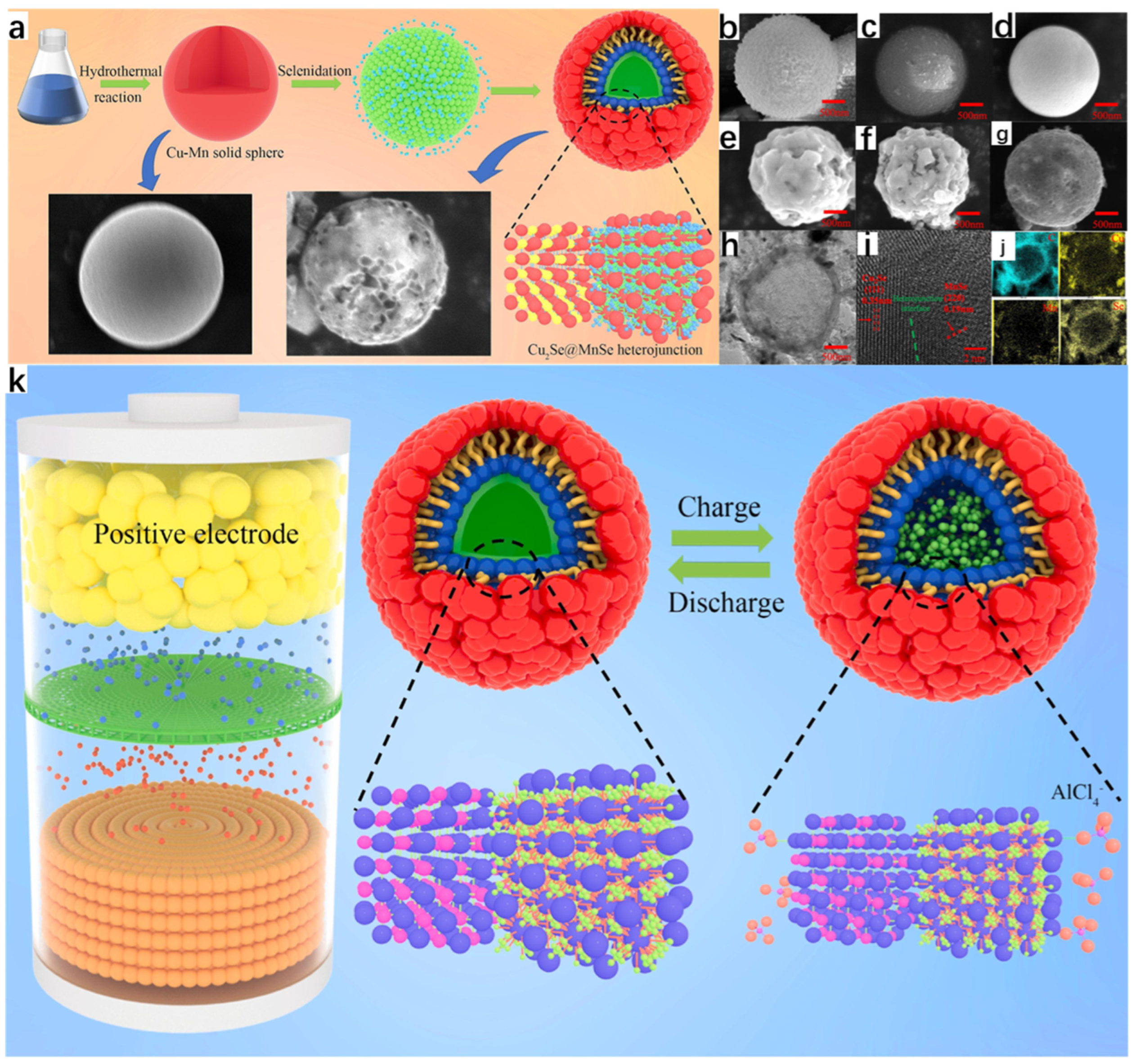
2.4.2. Solvothermal Method
2.5. Ion Exchange Method
2.5.1. Cation Exchange
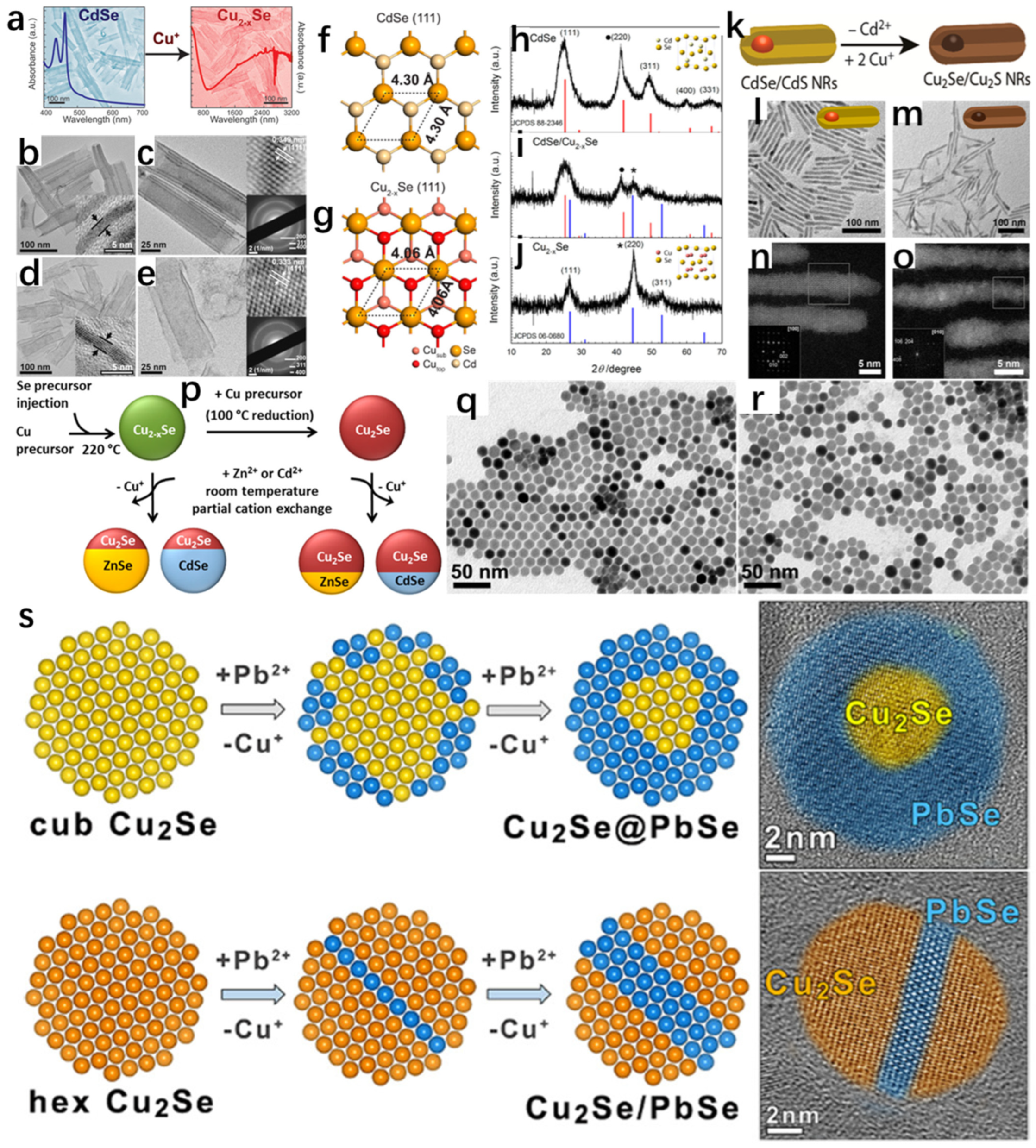
2.5.2. Anion Exchange
2.6. Summary of Methods
3. Energy Conversion and Storage
3.1. Energy Conversion
3.1.1. Electronic and Phonon Transport Properties of Cu2Se
3.1.2. Optimization of Thermoelectric Properties
3.1.3. Production of Thermoelectric Components
3.2. Energy Storage
3.2.1. Sodium-Ion Battery
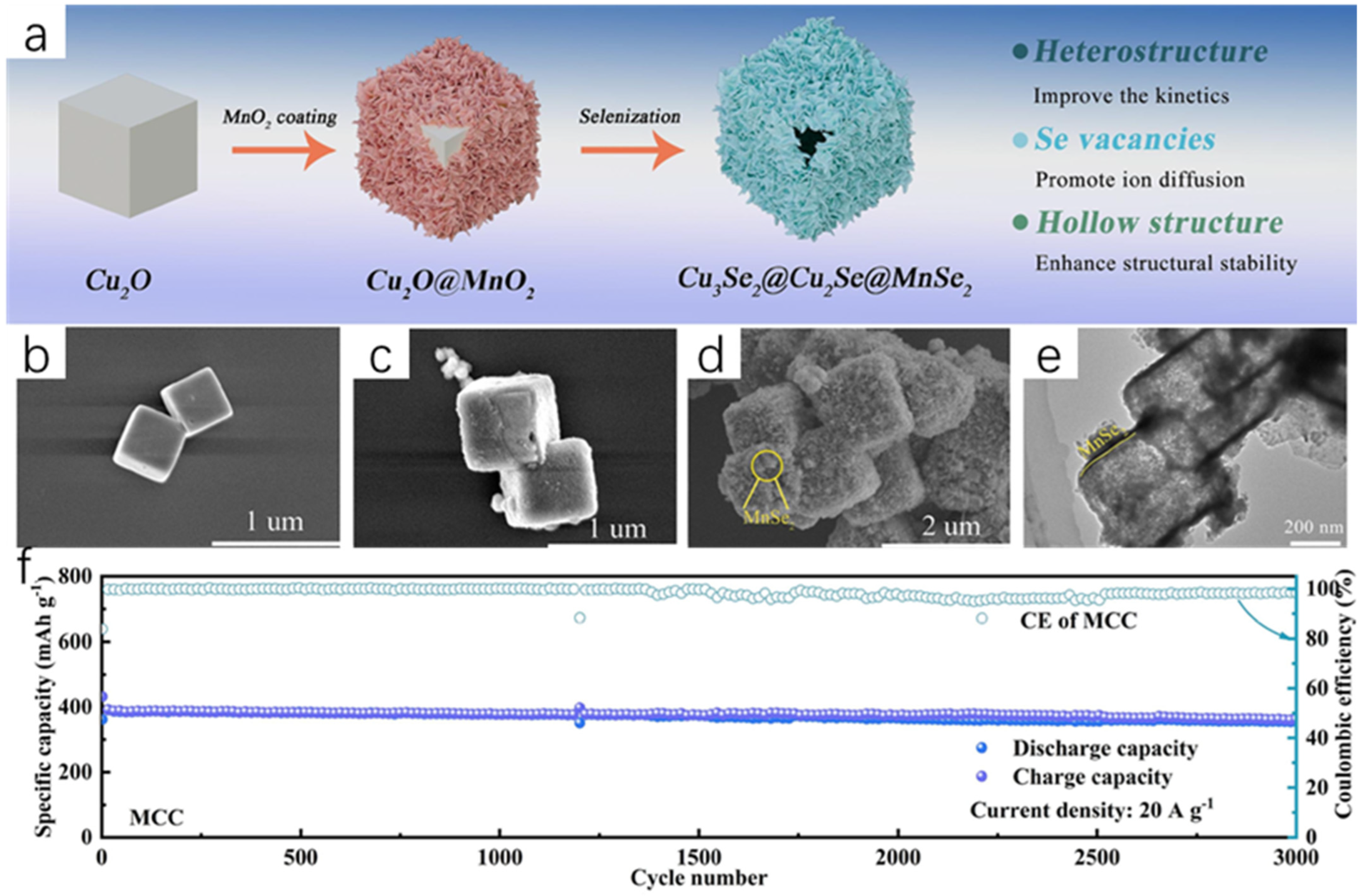
3.2.2. Water-Based Battery
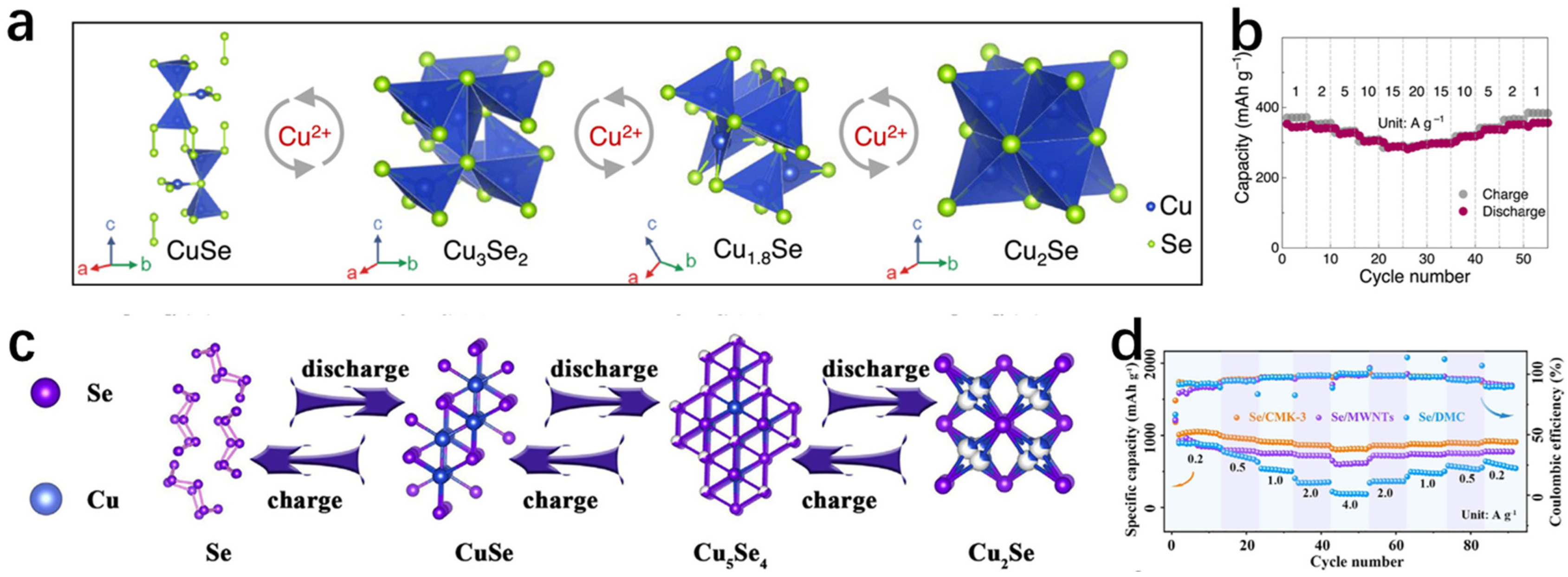
4. Summary and Prospects
- Material property optimization: Further enhancing the thermoelectric and electrochemical properties of Cu2Se-based materials through the development of more complex heterojunctions, porous structures or ordered defects.
- Novel composite material development: Develop multifunctional energy devices, such as integrated thermoelectricity-energy storage devices, with composite Cu2Se with high-performance materials, such as graphene and MXene.
- Green synthesis process: Explore low-cost, high-efficiency, and environmentally friendly synthesis methods, such as 3D printing or cold sintering technology, to promote the large-scale commercialization of Cu2Se-based materials.
- Multifunctional integrated appliances: Combine with advanced computational simulation techniques, and design new device structures to further enhance the application potential of Cu2Se-based materials in the fields of wearable devices and industrial waste heat recovery.
Author Contributions
Funding
Institutional Review Board Statement
Informed Consent Statement
Data Availability Statement
Conflicts of Interest
References
- He, J.; Tritt, T.M. Advances in Thermoelectric Materials Research: Looking Back and Moving Forward. Science 2017, 357, eaak9997. [Google Scholar] [CrossRef] [PubMed]
- Zhu, M.; He, B.; Zhang, K.; Hussain, S.; Li, T. Recent Progress of Poly(3-Hexylthiophene)-Based Materials for Thermoelectric Applications. Mater. Chem. Front. 2024, 8, 2454–2492. [Google Scholar] [CrossRef]
- Zhu, M.; Lu, C.; Liu, L. Progress and Challenges of Emerging MXene Based Materials for Thermoelectric Applications. iScience 2023, 26, 106718. [Google Scholar] [CrossRef] [PubMed]
- Xue, X.; Li, S.; Zhu, M. Recent Progress in Graphene-Based Materials for Thermoelectric Applications. RSC Adv. 2025, 15, 26919–26942. [Google Scholar] [CrossRef]
- Funahashi, S.; Guo, H.; Guo, J.; Baker, A.L.; Wang, K.; Shiratsuyu, K.; Randall, C.A. Cold Sintering and Co-Firing of a Multilayer Device with Thermoelectric Materials. J. Am. Ceram. Soc. 2017, 100, 3488–3496. [Google Scholar] [CrossRef]
- Yoo, B.Y.; Huang, C.-K.; Lim, J.R.; Herman, J.; Ryan, M.A.; Fleurial, J.-P.; Myung, N.V. Electrochemically Deposited Thermoelectric N-Type Bi2Te3 Thin Films. Electrochim. Acta 2005, 50, 4371–4377. [Google Scholar] [CrossRef]
- Liu, W.-D.; Yang, L.; Chen, Z.-G. Cu2Se Thermoelectrics: Property, Methodology, and Device. Nano Today 2020, 35, 100938. [Google Scholar] [CrossRef]
- Sun, S.; Rao, D.; Zhai, T.; Liu, Q.; Huang, H.; Liu, B.; Zhang, H.; Xue, L.; Xia, H. Synergistic Interface-Assisted Electrode–Electrolyte Coupling Toward Advanced Charge Storage. Adv. Mater. 2020, 32, 2005344. [Google Scholar] [CrossRef]
- Liang, G.; Mo, F.; Ji, X.; Zhi, C. Non-Metallic Charge Carriers for Aqueous Batteries. Nat. Rev. Mater. 2021, 6, 109–123. [Google Scholar] [CrossRef]
- He, B.; Zhang, K.; Zhu, M. Engineering of Copper Sulfide-Based Nanomaterials for Thermoelectric Application. Green Energy Environ. 2024, 10, 619–688. [Google Scholar] [CrossRef]
- Yang, Y.; Liu, L.; Li, S.; Zhu, M. Cu-Based Ternary Heterostructures for High-Performance Asymmetric Supercapacitors. ACS Appl. Energy Mater. 2024, 7, 7307–7315. [Google Scholar] [CrossRef]
- Haram, S.K.; Santhanam, K.S.V. Electroless Deposition of Orthorhombic Copper (I) Selenide and Its Room Temperature Phase Transformation to Cubic Structure. Thin Solid Films 1994, 238, 21–26. [Google Scholar] [CrossRef]
- Zhao, W.; Zhou, H.; Lu, K.; Li, Y.; Shi, W.; Ma, X. Electronic/Ionic Engineering Inspired Formation of Carbon-Encapsulated Cu3PSe4/Cu2Se Heterostructured Hollow Nanosphere for Trace Level Neurochemical Monitoring. Appl. Surf. Sci. 2023, 613, 156142. [Google Scholar] [CrossRef]
- Ma, X.; Li, Y.; Long, X.; Luo, H.; Xu, C.; Wang, G.; Zhao, W. Construction of Phosphorus-Doping with Spontaneously Developed Selenium Vacancies: Inducing Superior Ion-Diffusion Kinetics in Hollow Cu2Se@C Nanospheres for Efficient Sodium Storage. J. Energy Chem. 2023, 77, 227–238. [Google Scholar] [CrossRef]
- Yang, T.; Zhang, W.; Wu, J.; Zhu, S.; Wang, D.; Lei, C.; Zhao, Y. Synthesis of a Ni(OH)2@Cu2Se Hetero-Nanocage by Ion Exchange for Advanced Glucose Sensing in Serum and Beverages. Food Chem. 2023, 419, 136024. [Google Scholar] [CrossRef]
- Sankar, R.S.; Anwar, S.; Anwar, S. Enhanced Thermoelectric Power Factor in the Cu2Se System by the Incorporation of GO/MWCNT. Phys. B Condens. Matter 2023, 652, 414620. [Google Scholar] [CrossRef]
- Rapaka, S.S.; Anwar, S.; Singh, J.; Anwar, S. Transport Studies of Two-Step Synthesized Cu2Se-Graphene Nanocomposites. Phys. B Condens. Matter 2023, 665, 415044. [Google Scholar] [CrossRef]
- Sun, N.; Li, W.; Pang, C.; Zhong, D.; Li, M. Thermoelectric Properties of Cu2Se Sintered in High-Pressure H2 or N2 Atmosphere. Solid State Commun. 2021, 339, 114505. [Google Scholar] [CrossRef]
- Mac, T.K.; Ta, T.T.; Nguyen, H.T.; Hoang, N.V.; Pham, T.L.H.; Duong, V.T.; Pham, A.T.T.; Phan, B.T.; Cho, S.; Duong, A.T. The Impact of Sintering Temperature on the Thermoelectric Performance of Cu2Se Synthesized by Solid State Reaction Method. J. Solid State Chem. 2023, 322, 123998. [Google Scholar] [CrossRef]
- Butt, S.; Farooq, M.U.; Mahmood, W.; Salam, S.; Sultan, M.; Basit, M.A.; Ma, J.; Lin, Y.; Nan, C.-W. One-Step Rapid Synthesis of Cu2Se with Enhanced Thermoelectric Properties. J. Alloys Compd. 2019, 786, 557–564. [Google Scholar] [CrossRef]
- Wu, X.-J.; Huang, X.; Liu, J.; Li, H.; Yang, J.; Li, B.; Huang, W.; Zhang, H. Two-Dimensional CuSe Nanosheets with Microscale Lateral Size: Synthesis and Template-Assisted Phase Transformation. Angew. Chem. Int. Ed. 2014, 53, 5083–5087. [Google Scholar] [CrossRef]
- Nunna, R.; Qiu, P.; Yin, M.; Chen, H.; Hanus, R.; Song, Q.; Zhang, T.; Chou, M.-Y.; Agne, M.T.; He, J.; et al. Ultrahigh Thermoelectric Performance in Cu2Se-Based Hybrid Materials with Highly Dispersed Molecular CNTs. Energy Environ. Sci. 2017, 10, 1928–1935. [Google Scholar] [CrossRef]
- Dai, C.; Sheng, Z.; Tian, X.; Nie, Y.; Li, Y. Regulating Localized State Electron and Ordered Electron Transfer in Cu2Se Using Indium Element for Efficient Heterogeneous Fenton-like Process. Sep. Purif. Technol. 2024, 336, 126316. [Google Scholar] [CrossRef]
- Yang, B.; Yang, J.; Huang, Z.; Qin, L.; Lin, H.; Li, Q. Green Fabrication of Large-Size Cu2Se Hexagonal Sheets with Visible Light Photocatalytic Activity. Appl. Surf. Sci. 2021, 535, 147712. [Google Scholar] [CrossRef]
- Xie, W.; Liu, F.; Zheng, Y.; Ge, N.; Dai, B.; Zhang, X. Thermoelectric Performance Enhancement of Eco-Friendly Cu2Se through Incorporating CB4. RSC Adv. 2022, 12, 14112–14118. [Google Scholar] [CrossRef] [PubMed]
- Zhu, Y.; Tang, H.; Yun, X.; Xi, L.; Hu, Z. One-Pot Hydrothermal Synthesis of 3D Cu2Se/CoSe Composite as a Novel Battery-Type Cathode Material with Enhanced Capacitive Properties. J. Alloys Compd. 2021, 866, 158972. [Google Scholar] [CrossRef]
- Yang, T.; Shao, Y.; Hu, J.; Qu, J.; Yang, X.; Yang, F.; Ming Li, C. Ultrathin Layered 2D/2D Heterojunction of ReS2/High-Crystalline g-C3N4 for Significantly Improved Photocatalytic Hydrogen Evolution. Chem. Eng. J. 2022, 448, 137613. [Google Scholar] [CrossRef]
- Li, C.; Dong, X.; Zhang, Y.; Hu, J.; Yuan, J.; Li, G.; Chen, D.; Li, Y. Micro-Tailored g-C3N4 Enables Ru Single-Atom Loading for Efficient Photocatalytic H2 Evolution. Appl. Surf. Sci. 2022, 596, 153471. [Google Scholar] [CrossRef]
- Luo, J.; Han, H.; Wu, J.; Wang, X.; Feng, J.; Toan, S.; Wang, L.; Lai, Y. Excellent Photocatalytic Activity of MoO3-Adorned g-C3N4 Systems: Construction of S-Scheme Heterojunction. Appl. Surf. Sci. 2022, 604, 154512. [Google Scholar] [CrossRef]
- He, B.; Chen, S.; Cui, Y.; Chen, X.; Lei, Y.; Sun, J. Hollow Polymeric Ionic Liquid Spheres with Hierarchical Electron Distribution: A Novel Composite of g-C3N4 for Visible Light Photocatalytic Water Splitting Enhancement. Chem. Eng. J. 2022, 440, 135625. [Google Scholar] [CrossRef]
- Lin, F.; Zhou, S.; Wang, G.; Wang, J.; Gao, T.; Su, Y.; Wong, C.-P. Electrostatic Self-Assembly Combined with Microwave Hydrothermal Strategy: Construction of 1D/1D Carbon Nanofibers/Crystalline g-C3N4 Heterojunction for Boosting Photocatalytic Hydrogen Production. Nano Energy 2022, 99, 107432. [Google Scholar] [CrossRef]
- Liu, X.; Li, Y.; Li, P. Construction of Multi-Dimensional Cu2Se@amorphous Carbon@graphene Nanobelt/g-C3N4 Z-Scheme Heterojunctions for Photocatalytic Hydrogen Production. Colloids Surf. Physicochem. Eng. Asp. 2024, 686, 133411. [Google Scholar] [CrossRef]
- Zhang, C.; Gu, H.; Hu, Y.; Zhang, W.; Li, Z. Investigation on the Energy Storage Performance of Cu2Se@MnSe Heterojunction Hollow Spherical Shell for Aluminum-Ion Battery. Chem. Eng. J. 2023, 474, 145688. [Google Scholar] [CrossRef]
- Zhang, Z.; Wen, G.; Luo, D.; Ren, B.; Zhu, Y.; Gao, R.; Dou, H.; Sun, G.; Feng, M.; Bai, Z.; et al. “Two Ships in a Bottle” Design for Zn–Ag–O Catalyst Enabling Selective and Long-Lasting CO2 Electroreduction. J. Am. Chem. Soc. 2021, 143, 6855–6864. [Google Scholar] [CrossRef] [PubMed]
- Pei, J.; Wang, T.; Sui, R.; Zhang, X.; Zhou, D.; Qin, F.; Zhao, X.; Liu, Q.; Yan, W.; Dong, J.; et al. N-Bridged Co–N–Ni: New Bimetallic Sites for Promoting Electrochemical CO2 Reduction. Energy Environ. Sci. 2021, 14, 3019–3028. [Google Scholar] [CrossRef]
- Saha, P.; Amanullah, S.; Dey, A. Selectivity in Electrochemical CO2 Reduction. Acc. Chem. Res. 2022, 55, 134–144. [Google Scholar] [CrossRef]
- Wang, G.; Chen, J.; Ding, Y.; Cai, P.; Yi, L.; Li, Y.; Tu, C.; Hou, Y.; Wen, Z.; Dai, L. Electrocatalysis for CO2 Conversion: From Fundamentals to Value-Added Products. Chem. Soc. Rev. 2021, 50, 4993–5061. [Google Scholar] [CrossRef]
- Wang, X.; Mu, H.; Zhu, M.; Li, F.; Li, J. Regulating the Cu2Se-SnO Nanosheet Heterostructure Interface for Efficient CO2 Conversion to Tunable Syngas Ratios. J. Alloys Compd. 2024, 985, 174108. [Google Scholar] [CrossRef]
- Lv, S.; Yuan, H.; Xing, M.; Li, K.; Leng Pak, Y.; Gao, X.; Zhang, D.; Mou, H.; Song, J. Surface Vacancy Engineering Powered Reverse Cation Exchange in Preparing CuZnS Hollow Nanoboxs for Efficient Photocatalytic Hydrogen Evolution. Chem. Eng. J. 2024, 492, 152025. [Google Scholar] [CrossRef]
- Youn, Y.; Yoon, S.; Kim, T.W.; Hong, S.K.; Cho, K. Significant Improvement of Adsorption Thermal Energy Storage of Zeolite by Simple Cation Exchange, Inducing Strong Polarization of Water. J. Energy Storage 2024, 89, 111805. [Google Scholar] [CrossRef]
- Xie, Y.; Wang, Y.; Zhou, Y.; Wang, F.; Xu, Y.; Rao, S.; Zhao, J. Cation Exchange Strategy to Construct Co-Doped BiOBr Nanosheets for High-Efficient Photocatalytic CO2 to CO. Appl. Catal. A Gen. 2024, 669, 119504. [Google Scholar] [CrossRef]
- Son, D.H.; Hughes, S.M.; Yin, Y.; Paul Alivisatos, A. Cation Exchange Reactions in Ionic Nanocrystals. Science 2004, 306, 1009–1012. [Google Scholar] [CrossRef] [PubMed]
- Su, Y.; Li, G.; Guo, Z.; Li, Y.-Y.; Li, Y.-X.; Huang, X.-J.; Liu, J.-H. Cation-Exchange Synthesis of Cu2Se Nanobelts and Thermal Conversion to Porous CuO Nanobelts with Highly Selective Sensing toward H2S. ACS Appl. Nano Mater. 2018, 1, 245–253. [Google Scholar] [CrossRef]
- Casu, A.; Genovese, A.; Manna, L.; Longo, P.; Buha, J.; Botton, G.A.; Lazar, S.; Kahaly, M.U.; Schwingenschloegl, U.; Prato, M.; et al. Cu2Se and Cu Nanocrystals as Local Sources of Copper in Thermally Activated In Situ Cation Exchange. ACS Nano 2016, 10, 2406–2414. [Google Scholar] [CrossRef]
- Wang, Y.; Zhukovskyi, M.; Tongying, P.; Tian, Y.; Kuno, M. Synthesis of Ultrathin and Thickness-Controlled Cu2−xSe Nanosheets via Cation Exchange. J. Phys. Chem. Lett. 2014, 5, 3608–3613. [Google Scholar] [CrossRef] [PubMed]
- van der Stam, W.; Bladt, E.; Rabouw, F.T.; Bals, S.; de Mello Donega, C. Near-Infrared Emitting CuInSe2/CuInS2 Dot Core/Rod Shell Heteronanorods by Sequential Cation Exchange. ACS Nano 2015, 9, 11430–11438. [Google Scholar] [CrossRef]
- Rivest, J.B.; Jain, P.K. Cation Exchange on the Nanoscale: An Emerging Technique for New Material Synthesis, Device Fabrication, and Chemical Sensing. Chem. Soc. Rev. 2012, 42, 89–96. [Google Scholar] [CrossRef]
- Lesnyak, V.; Brescia, R.; Messina, G.C.; Manna, L. Cu Vacancies Boost Cation Exchange Reactions in Copper Selenide Nanocrystals. J. Am. Chem. Soc. 2015, 137, 9315–9323. [Google Scholar] [CrossRef]
- De Trizio, L.; Manna, L. Forging Colloidal Nanostructures via Cation Exchange Reactions. Chem. Rev. 2016, 116, 10852–10887. [Google Scholar] [CrossRef]
- Gupta, S.; Kershaw, S.V.; Rogach, A.L. 25th Anniversary Article: Ion Exchange in Colloidal Nanocrystals. Adv. Mater. 2013, 25, 6923–6944. [Google Scholar] [CrossRef]
- Kershaw, S.V.; Abdelazim, N.M.; Zhao, Y.; Susha, A.S.; Zhovtiuk, O.; Teoh, W.Y.; Rogach, A.L. Investigation of the Exchange Kinetics and Surface Recovery of CdxHg1−xTe Quantum Dots during Cation Exchange Using a Microfluidic Flow Reactor. Chem. Mater. 2017, 29, 2756–2768. [Google Scholar] [CrossRef]
- Fan, Z.; Lin, L.-C.; Buijs, W.; Vlugt, T.J.H.; van Huis, M.A. Atomistic Understanding of Cation Exchange in PbS Nanocrystals Using Simulations with Pseudoligands. Nat. Commun. 2016, 7, 11503. [Google Scholar] [CrossRef] [PubMed]
- Chakraborty, P.; Jin, Y.; Barrows, C.J.; Dunham, S.T.; Gamelin, D.R. Kinetics of Isovalent (Cd2+) and Aliovalent (In3+) Cation Exchange in Cd1−xMnxSe Nanocrystals. J. Am. Chem. Soc. 2016, 138, 12885–12893. [Google Scholar] [CrossRef] [PubMed]
- White, S.L.; Banerjee, P.; Chakraborty, I.; Jain, P.K. Ion Exchange Transformation of Magic-Sized Clusters. Chem. Mater. 2016, 28, 8391–8398. [Google Scholar] [CrossRef]
- Meir, N.; Martín-García, B.; Moreels, I.; Oron, D. Revisiting the Anion Framework Conservation in Cation Exchange Processes. Chem. Mater. 2016, 28, 7872–7877. [Google Scholar] [CrossRef]
- Dzhagan, V.; Kempken, B.; Valakh, M.; Parisi, J.; Kolny-Olesiak, J.; Zahn, D.R.T. Probing the Structure of CuInS2-ZnS Core-Shell and Similar Nanocrystals by Raman Spectroscopy. Appl. Surf. Sci. 2017, 395, 24–28. [Google Scholar] [CrossRef]
- Zheng, Z.; Sun, Y.-Y.; Xie, W.; Zhao, J.; Zhang, S. Solvent-Based Atomistic Theory for Doping Colloidal-Synthesized Quantum Dots via Cation Exchange. J. Phys. Chem. C 2016, 120, 27085–27090. [Google Scholar] [CrossRef]
- Enright, M.J.; Sarsito, H.; Cossairt, B.M. Quantifying Cation Exchange of Cd2+ in ZnTe: A Challenge for Accessing Type II Heterostructures. Chem. Mater. 2017, 29, 666–672. [Google Scholar] [CrossRef]
- Song, J.; Ma, C.; Zhang, W.; Li, X.; Zhang, W.; Wu, R.; Cheng, X.; Ali, A.; Yang, M.; Zhu, L.; et al. Bandgap and Structure Engineering via Cation Exchange: From Binary Ag2S to Ternary AgInS2, Quaternary AgZnInS Alloy and AgZnInS/ZnS Core/Shell Fluorescent Nanocrystals for Bioimaging. ACS Appl. Mater. Interfaces 2016, 8, 24826–24836. [Google Scholar] [CrossRef]
- Sun, Z.; Liu, X.; Yue, Q.; Jia, H.; Du, P. Cadmium Sulfide Nanorods Decorated with Copper Sulfide via One-Step Cation Exchange Approach for Enhanced Photocatalytic Hydrogen Evolution under Visible Light. ChemCatChem 2016, 8, 157–162. [Google Scholar] [CrossRef]
- Gariano, G.; Lesnyak, V.; Brescia, R.; Bertoni, G.; Dang, Z.; Gaspari, R.; De Trizio, L.; Manna, L. Role of the Crystal Structure in Cation Exchange Reactions Involving Colloidal Cu2Se Nanocrystals. J. Am. Chem. Soc. 2017, 139, 9583–9590. [Google Scholar] [CrossRef]
- Zhao, Y.; Wang, X.; Gao, F.; Wang, C.; Yang, Z.; Wu, H.; Li, C.; Cheng, L.; Peng, R. Facile Preparation of Cu2Se Nanosheets as Dual-Functional Antibacterial Agents. ACS Appl. Bio Mater. 2020, 3, 1418–1425. [Google Scholar] [CrossRef] [PubMed]
- Wang, X.; Zhong, X.; Lei, H.; Geng, Y.; Zhao, Q.; Gong, F.; Yang, Z.; Dong, Z.; Liu, Z.; Cheng, L. Hollow Cu2Se Nanozymes for Tumor Photothermal-Catalytic Therapy. Chem. Mater. 2019, 31, 6174–6186. [Google Scholar] [CrossRef]
- Ramakrishnan, K.; Ajitha, B.; Ashok Kumar Reddy, Y. Review on Metal Sulfide-Based Nanostructures for Photodetectors: From Ultraviolet to Infrared Regions. Sens. Actuators Phys. 2023, 349, 114051. [Google Scholar] [CrossRef]
- Cui, Y.; Zhou, Z.; Li, T.; Wang, K.; Li, J.; Wei, Z. Versatile Crystal Structures and (Opto)Electronic Applications of the 2D Metal Mono-, Di-, and Tri-Chalcogenide Nanosheets. Adv. Funct. Mater. 2019, 29, 1900040. [Google Scholar] [CrossRef]
- Zhang, Y.; Zhou, Q.; Zhu, J.; Yan, Q.; Dou, S.X.; Sun, W. Nanostructured Metal Chalcogenides for Energy Storage and Electrocatalysis. Adv. Funct. Mater. 2017, 27, 1702317. [Google Scholar] [CrossRef]
- Jian, Y.; Han, L.; Kong, X.; Xie, T.; Kou, D.; Zhou, W.; Zhou, Z.; Yuan, S.; Meng, Y.; Qi, Y.; et al. Segmented Control of Selenization Environment for High-Quality Cu2ZnSn(S,Se)4 Films Toward Efficient Kesterite Solar Cells. Small Methods 2024, 8, 2400041. [Google Scholar] [CrossRef]
- Xue, L.; Zhang, Z.; Shen, W.; Ma, H.; Zhang, Y.; Fang, C.; Jia, X. Thermoelectric Performance of Cu2Se Bulk Materials by High-Temperature and High-Pressure Synthesis. J. Mater. 2019, 5, 103–110. [Google Scholar] [CrossRef]
- Yang, D.; Su, X.; Yan, Y.; He, J.; Uher, C.; Tang, X. Mechanochemical Synthesis of High Thermoelectric Performance Bulk Cu2X (X = S, Se) Materials. APL Mater. 2016, 4, 116110. [Google Scholar] [CrossRef]
- Li, J.; Liu, G.; Wu, X.; He, G.; Yang, Z.; Li, J. Reaction Mechanism in Mechanochemical Synthesis of Cu2−xSe. Ceram. Int. 2018, 44, 22172–22175. [Google Scholar] [CrossRef]
- Hu, Q.; Zhu, Z.; Zhang, Y.; Li, X.-J.; Song, H.; Zhang, Y. Remarkably High Thermoelectric Performance of Cu2−xLixSe Bulks with Nanopores. J. Mater. Chem. A 2018, 6, 23417–23424. [Google Scholar] [CrossRef]
- Yang, L.; Chen, Z.-G.; Han, G.; Hong, M.; Zou, J. Impacts of Cu Deficiency on the Thermoelectric Properties of Cu2−xSe Nanoplates. Acta Mater. 2016, 113, 140–146. [Google Scholar] [CrossRef]
- Mishra, R.R.; Sharma, A.K. Microwave–Material Interaction Phenomena: Heating Mechanisms, Challenges and Opportunities in Material Processing. Compos. Part Appl. Sci. Manuf. 2016, 81, 78–97. [Google Scholar] [CrossRef]
- Gupta, M.; Wong, W.L.E. Enhancing Overall Mechanical Performance of Metallic Materials Using Two-Directional Microwave Assisted Rapid Sintering. Scr. Mater. 2005, 52, 479–483. [Google Scholar] [CrossRef]
- Rudradawong, C.; Sukwisute, P.; Limsuwan, P.; Harnwunggmoung, A.; Horprathum, M.; Sakdanuphab, R.; Sakulkalavek, A. Energy-Saving Synthesis and β-Phase Enhancement of Cu2Se Thermoelectric Materials via the Microwave Hybrid Heating Technique. J. Alloys Compd. 2021, 879, 160513. [Google Scholar] [CrossRef]
- Bailey, T.P.; Hui, S.; Xie, H.; Olvera, A.; Poudeu, P.F.P.; Tang, X.; Uher, C. Enhanced ZT and Attempts to Chemically Stabilize Cu2Se via Sn Doping. J. Mater. Chem. A 2016, 4, 17225–17235. [Google Scholar] [CrossRef]
- Geng, Z.; Shi, D.; Shi, L.; Li, Y.; Snyder, G.J.; Lam, K. Conventional Sintered Cu2−xSe Thermoelectric Material. J. Mater. 2019, 5, 626–633. [Google Scholar] [CrossRef]
- Sakulkalavek, A.; Rudradawong, C.; Gobpant, J.; Harnwunggmoung, A.; Limsuwan, P.; Voraud, A.; Sakdanuphab, R.; Somdock, N. Enhancement of Thermoelectric Properties in Rapidly Synthesised β-Cu2Se Using Optimized Cu Content and Microwave Hybrid Heating. Ceram. Int. 2024, 50 Pt B, 3680–3685. [Google Scholar] [CrossRef]
- Liu, H.; Shi, X.; Xu, F.; Zhang, L.; Zhang, W.; Chen, L.; Li, Q.; Uher, C.; Day, T.; Snyder, G.J. Copper Ion Liquid-like Thermoelectrics. Nat. Mater. 2012, 11, 422–425. [Google Scholar] [CrossRef]
- Zhao, L.; Wang, X.; Yun, F.F.; Wang, J.; Cheng, Z.; Dou, S.; Wang, J.; Snyder, G.J. The Effects of Te2− and I− Substitutions on the Electronic Structures, Thermoelectric Performance, and Hardness in Melt-Quenched Highly Dense Cu2−xSe. Adv. Electron. Mater. 2015, 1, 1400015. [Google Scholar] [CrossRef]
- Su, X.; Fu, F.; Yan, Y.; Zheng, G.; Liang, T.; Zhang, Q.; Cheng, X.; Yang, D.; Chi, H.; Tang, X.; et al. Self-Propagating High-Temperature Synthesis for Compound Thermoelectrics and New Criterion for Combustion Processing. Nat. Commun. 2014, 5, 4908. [Google Scholar] [CrossRef] [PubMed]
- Butt, S.; Xu, W.; Farooq, M.U.; Ren, G.K.; Zhang, Q.; Zhu, Y.; Khan, S.U.; Liu, L.; Yu, M.; Mohmed, F.; et al. Enhanced Thermoelectricity in High-Temperature β-Phase Copper(I) Selenides Embedded with Cu2Te Nanoclusters. ACS Appl. Mater. Interfaces 2016, 8, 15196–15204. [Google Scholar] [CrossRef] [PubMed]
- Zhang, J.; Zhu, T.; Zhang, C.; Yan, Y.; Tan, G.; Liu, W.; Su, X.; Tang, X. In-Situ Formed Nano-Pore Induced by Ultrasonication Boosts the Thermoelectric Performance of Cu2Se Compounds. J. Alloys Compd. 2021, 881, 160639. [Google Scholar] [CrossRef]
- Lan, R.; Otoo, S.L.; Yuan, P.; Wang, P.; Yuan, Y.; Jiang, X. Thermoelectric Properties of Sn Doped GeTe Thin Films. Appl. Surf. Sci. 2020, 507, 145025. [Google Scholar] [CrossRef]
- Francioso, L.; De Pascali, C.; Farella, I.; Martucci, C.; Cretì, P.; Siciliano, P.; Perrone, A. Flexible Thermoelectric Generator for Wearable Biometric Sensors. In Proceedings of the 2010 IEEE SENSORS, Waikoloa, HI, USA, 1–4 November 2010; pp. 747–750. [Google Scholar] [CrossRef]
- Yu, J.; Liu, B.; Zhang, T.; Song, Z.; Feng, S.; Chen, B. Effects of Ge Doping on the Properties of Sb2Te3 Phase-Change Thin Films. Appl. Surf. Sci. 2007, 253, 6125–6129. [Google Scholar] [CrossRef]
- Sun, Y.; Christensen, M.; Johnsen, S.; Nong, N.V.; Ma, Y.; Sillassen, M.; Zhang, E.; Palmqvist, A.E.C.; Bøttiger, J.; Iversen, B.B. Low-Cost High-Performance Zinc Antimonide Thin Films for Thermoelectric Applications. Adv. Mater. 2012, 24, 1693–1696. [Google Scholar] [CrossRef]
- Deng, Y.; Liang, H.; Wang, Y.; Zhang, Z.; Tan, M.; Cui, J. Growth and Transport Properties of Oriented Bismuth Telluride Films. J. Alloys Compd. 2011, 509, 5683–5687. [Google Scholar] [CrossRef]
- Mu, X.; Zhou, H.; He, D.; Zhao, W.; Wei, P.; Zhu, W.; Nie, X.; Liu, H.; Zhang, Q. Enhanced Electrical Properties of Stoichiometric Bi0.5Sb1.5Te3 Film with High-Crystallinity via Layer-by-Layer in-Situ Growth. Nano Energy 2017, 33, 55–64. [Google Scholar] [CrossRef]
- Horide, T.; Murakami, Y.; Hirayama, Y.; Ishimaru, M.; Matsumoto, K. Thermoelectric Property in Orthorhombic-Domained SnSe Film. ACS Appl. Mater. Interfaces 2019, 11, 27057–27063. [Google Scholar] [CrossRef]
- Lal, S.; Razeeb, K.M.; Gautam, D. Enhanced Thermoelectric Properties of Electrodeposited Cu-Doped Te Films. ACS Appl. Energy Mater. 2020, 3, 3262–3268. [Google Scholar] [CrossRef]
- Kim, S.J.; We, J.H.; Cho, B.J. A Wearable Thermoelectric Generator Fabricated on a Glass Fabric. Energy Environ. Sci. 2014, 7, 1959–1965. [Google Scholar] [CrossRef]
- Chowdhury, I.; Prasher, R.; Lofgreen, K.; Chrysler, G.; Narasimhan, S.; Mahajan, R.; Koester, D.; Alley, R.; Venkatasubramanian, R. On-Chip Cooling by Superlattice-Based Thin-Film Thermoelectrics. Nat. Nanotechnol. 2009, 4, 235–238. [Google Scholar] [CrossRef]
- Jin, S.; Sun, T.; Fan, Y.; Wang, L.; Zhu, M.; Yang, J.; Jiang, W. Synthesis of Freestanding PEDOT:PSS/PVA@Ag NPs Nanofiber Film for High-Performance Flexible Thermoelectric Generator. Polymer 2019, 167, 102–108. [Google Scholar] [CrossRef]
- Venkatasubramanian, R.; Siivola, E.; Colpitts, T.; O’Quinn, B. Thin-Film Thermoelectric Devices with High Room-Temperature Figures of Merit. Nature 2001, 413, 597–602. [Google Scholar] [CrossRef] [PubMed]
- Yonezawa, S.; Tabuchi, T.; Takashiri, M. Atomic Composition Changes in Bismuth Telluride Thin Films by Thermal Annealing and Estimation of Their Thermoelectric Properties Using Experimental Analyses and First-Principles Calculations. J. Alloys Compd. 2020, 841, 155697. [Google Scholar] [CrossRef]
- Oztan, C.Y.; Hamawandi, B.; Zhou, Y.; Ballikaya, S.; Toprak, M.S.; Leblanc, R.M.; Coverstone, V.; Celik, E. Thermoelectric Performance of Cu2Se Doped with Rapidly Synthesized Gel-like Carbon Dots. J. Alloys Compd. 2021, 864, 157916. [Google Scholar] [CrossRef]
- Fan, P.; Huang, X.; Chen, T.; Li, F.; Chen, Y.; Jabar, B.; Chen, S.; Ma, H.; Liang, G.; Luo, J.; et al. α-Cu2Se Thermoelectric Thin Films Prepared by Copper Sputtering into Selenium Precursor Layers. Chem. Eng. J. 2021, 410, 128444. [Google Scholar] [CrossRef]
- Rapaka, S.S.; Anwar, S.; Anwar, S. Optimizing Thermoelectric Power Factor in Magnetron Sputtered Cu2Se Thin Films by Varying Substrate Temperature and Synergy of Cu/Se Ratio. Ceram. Int. 2024, 50, 15879–15887. [Google Scholar] [CrossRef]
- Li, Y.; Zhong, Y.; Zhang, D.; Niu, J.; Nisar, M.; Wei, M.; Liang, G.; Fan, P.; Zheng, Z. Enhanced Thermoelectric Properties of Cu2Se Flexible Thin Films by Optimizing Growth Temperature and Elemental Composition. ACS Appl. Energy Mater. 2022, 5, 13964–13970. [Google Scholar] [CrossRef]
- Ding, Y.; Qiu, Y.; Cai, K.; Yao, Q.; Chen, S.; Chen, L.; He, J. High Performance N-Type Ag2Se Film on Nylon Membrane for Flexible Thermoelectric Power Generator. Nat. Commun. 2019, 10, 841. [Google Scholar] [CrossRef]
- Shi, Y.; Wang, Y.; Mei, D.; Feng, B.; Chen, Z. Design and Fabrication of Wearable Thermoelectric Generator Device for Heat Harvesting. IEEE Robot. Autom. Lett. 2018, 3, 373–378. [Google Scholar] [CrossRef]
- Zhang, D.; Li, L.; Zhang, X.; Guan, L.; Jin, S.; Jia, J.; Wen, J.; Zeng, W. In Situ Synthesized Staggered-Layer-Boosted Flexible Ag2Se and Cu2Se Thin Films for Wearable Thermoelectric Power Generators. Adv. Funct. Mater. 2025, 35, 2419392. [Google Scholar] [CrossRef]
- He, S.; Lehmann, S.; Bahrami, A.; Nielsch, K. Current State-of-the-Art in the Interface/Surface Modification of Thermoelectric Materials. Adv. Energy Mater. 2021, 11, 2101877. [Google Scholar] [CrossRef]
- Shittu, S.; Li, G.; Zhao, X.; Ma, X. Review of Thermoelectric Geometry and Structure Optimization for Performance Enhancement. Appl. Energy 2020, 268, 115075. [Google Scholar] [CrossRef]
- Jiang, D.; Lian, M.; Xu, M.; Sun, Q.; Xu, B.B.; Thabet, H.K.; El-Bahy, S.M.; Ibrahim, M.M.; Huang, M.; Guo, Z. Advances in Triboelectric Nanogenerator Technology—Applications in Self-Powered Sensors, Internet of Things, Biomedicine, and Blue Energy. Adv. Compos. Hybrid Mater. 2023, 6, 57. [Google Scholar] [CrossRef]
- Xiang, T.; Chen, X.; Sun, H.; Liu, D.; Jiang, Y.; Chen, S.; Xie, Y.; Zhang, S. Advances in Liquid-Solid Triboelectric Nanogenerators and Its Applications. J. Mater. Sci. Technol. 2025, 214, 153–169. [Google Scholar] [CrossRef]
- Amini, S.; Muktar Ahmed, R.F.S.; Madanahalli Ankanathappa, S.; Chandrashekara Shastry, M.H.; Shivanna, M.; Sannathammegowda, K. Investigating the Annealing Effects on the Performance of Polyvinyl Alcohol-Graphite-Based Triboelectric Nanogenerator. Sens. Actuators Phys. 2024, 372, 115309. [Google Scholar] [CrossRef]
- Lourdhusamy, V.; Paulraj, I.; Kannan, V.P.; Liu, C.-J. Synergistic Enhancement of Cu2Se Thermoelectric Properties via Te and S Co-Doping: Aqueous Synthesis and Cold-Press Sintering for Power Generation. J. Mater. Chem. A 2025, 13, 6027–6041. [Google Scholar] [CrossRef]
- Choo, S.; Lee, J.; Şişik, B.; Jung, S.-J.; Kim, K.; Yang, S.E.; Jo, S.; Nam, C.; Ahn, S.; Lee, H.S.; et al. Geometric Design of Cu2Se-Based Thermoelectric Materials for Enhancing Power Generation. Nat. Energy 2024, 9, 1105–1116. [Google Scholar] [CrossRef]
- Xu, Y.; Liu, X.; Su, H.; Jiang, S.; Zhang, J.; Li, D. Hierarchical Bimetallic Selenides CoSe2–MoSe2/rGO for Sodium/Potassium-Ion Batteries Anode: Insights into the Intercalation and Conversion Mechanism. Energy Environ. Mater. 2022, 5, 627–636. [Google Scholar] [CrossRef]
- Yang, M.; Luo, Z.; Wang, X.; Cao, X.; Mao, W.; Pan, Y.; Dai, C.; Pan, J. Revealing Sodium Storage Mechanism of Hard Carbon Anodes through In-Situ Investigation of Mechano-Electrochemical Coupling Behavior. J. Energy Chem. 2023, 86, 227–236. [Google Scholar] [CrossRef]
- Wang, X.; Xu, Y.; Liu, X.; Tan, L.; Gu, H.; Du, X.; Li, D. Delving into the Dissimilarities in Electrochemical Performance and Underlying Mechanisms for Sodium and Potassium Ion Storage in N-Doped Carbon-Encapsulated Metallic Cu2Se Nanocubes. J. Energy Chem. 2024, 95, 336–347. [Google Scholar] [CrossRef]
- Meng, W.; Dang, Z.; Li, D.; Jiang, L.; Fang, D. Efficient Sodium Storage in Selenium Electrodes Achieved by Selenium Doping and Copper Current Collector Induced Displacement Redox Mechanisms. Adv. Funct. Mater. 2022, 32, 2204364. [Google Scholar] [CrossRef]
- Zhao, S.; Sewell, C.D.; Liu, R.; Jia, S.; Wang, Z.; He, Y.; Yuan, K.; Jin, H.; Wang, S.; Liu, X.; et al. SnO2 as Advanced Anode of Alkali-Ion Batteries: Inhibiting Sn Coarsening by Crafting Robust Physical Barriers, Void Boundaries, and Heterophase Interfaces for Superior Electrochemical Reaction Reversibility. Adv. Energy Mater. 2020, 10, 1902657. [Google Scholar] [CrossRef]
- Yue, L.; Wang, D.; Wu, Z.; Zhao, W.; Ren, Y.; Zhang, L.; Zhong, B.; Li, N.; Tang, B.; Liu, Q.; et al. Polyrrole-Encapsulated Cu2Se Nanosheets in Situ Grown on Cu Mesh for High Stability Sodium-Ion Battery Anode. Chem. Eng. J. 2022, 433, 134477. [Google Scholar] [CrossRef]
- Wu, J.; Wang, G.; Zhang, W.; Wang, L.; Peng, J.; Li, Q.; Liang, Z.; Fan, W.; Wang, J.; Huang, S. Universal Architecture and Defect Engineering Dual Strategy for Hierarchical Antimony Phosphate Composite toward Fast and Durable Sodium Storage. J. Energy Chem. 2024, 90, 110–119. [Google Scholar] [CrossRef]
- Verduzco, J.C.; Bettes, B.; Hu, Q.; Marinero, E.E. A Review on Defect Engineering of Anode Materials for Solid-State Battery Applications. Ionics 2023, 29, 439–453. [Google Scholar] [CrossRef]
- Shi, J.; Liu, S.; Zhang, L.; Yang, B.; Shu, L.; Yang, Y.; Ren, M.; Wang, Y.; Chen, J.; Chen, W.; et al. Smart Textile-Integrated Microelectronic Systems for Wearable Applications. Adv. Mater. 2020, 32, 1901958. [Google Scholar] [CrossRef]
- Wang, J.; Shi, H.; Wang, W.; Xu, Z.; Hong, C.; Xue, Y.; Tian, F. Defect Engineering of Graphynes for Energy Storage and Conversion. Chem. Eng. J. 2022, 432, 133617. [Google Scholar] [CrossRef]
- Zhao, Y.; Tripathi, M.; Čerņevičs, K.; Avsar, A.; Ji, H.G.; Gonzalez Marin, J.F.; Cheon, C.-Y.; Wang, Z.; Yazyev, O.V.; Kis, A. Electrical Spectroscopy of Defect States and Their Hybridization in Monolayer MoS2. Nat. Commun. 2023, 14, 44. [Google Scholar] [CrossRef]
- Sun, Z.; Qu, D.; Han, D.; Gu, Z.; Guo, J.; Zhao, X.; Ma, Y.; Zhao, B.; Song, Z.; Wu, X.; et al. Solvent-Free Ultrafast Construction of Se-Deficient Heterojunctions of Bimetallic Selenides toward Flexible Sodium-Ion Full Batteries. Adv. Mater. 2024, 36, 2308987. [Google Scholar] [CrossRef] [PubMed]
- Li, S.; Qian, G.; He, X.; Huang, X.; Lee, S.-J.; Jiang, Z.; Yang, Y.; Wang, W.-N.; Meng, D.; Yu, C.; et al. Thermal-Healing of Lattice Defects for High-Energy Single-Crystalline Battery Cathodes. Nat. Commun. 2022, 13, 704. [Google Scholar] [CrossRef] [PubMed]
- Liu, F.; Zong, J.; Liang, Y.; Zhang, M.; Song, K.; Mi, L.; Feng, J.; Xiong, S.; Xi, B. Ordered Vacancies as Sodium Ion Micropumps in Cu-Deficient Copper Indium Diselenide to Enhance Sodium Storage. Adv. Mater. 2024, 36, 2403131. [Google Scholar] [CrossRef]
- Cheng, J.; Niu, Z.; Zhao, Z.; Pei, X.; Zhang, S.; Wang, H.; Li, D.; Guo, Z. Enhanced Ion/Electron Migration and Sodium Storage Driven by Different MoS2-ZnIn2S4 Heterointerfaces. Adv. Energy Mater. 2023, 13, 2203248. [Google Scholar] [CrossRef]
- Zhang, Y.; Chen, Y.; Jiang, Y.; Wang, J.; Zheng, X.; Han, B.; Xia, K.; Gao, Q.; Cai, Z.; Zhou, C.; et al. Construction of VS2/VO Heterostructure via Hydrolysis-Oxidation Coupling Reaction with Superior Sodium Storage Properties. Adv. Funct. Mater. 2023, 33, 2212785. [Google Scholar] [CrossRef]
- Yang, K.; Li, Z.; Zhang, W.; Geng, X.; Ma, H.; Zhang, J.; Mo, H.; Zhang, Z.; Wang, T.; Xu, J.; et al. Hollow Nanocubes of MnSe2@Cu3Se2/Cu2Se with Heterostructure for Ultrahigh-Rate Sodium Storage. Chem. Eng. J. 2025, 507, 160419. [Google Scholar] [CrossRef]
- Lu, C.; Li, B.; Shi, M.; Li, Q.; Liu, K.; Lu, C.; Liao, J.; Hu, Z.; Wei, X.; Li, C.; et al. Cu-Driven Active Cu2Se@MXene Heterointerface Reconstruction and Co Electron Reservoir Toward Superior Sodium Storage. Adv. Energy Mater. 2025, 15, 2405706. [Google Scholar] [CrossRef]
- Wu, B.; Zhang, Y.; Wang, Z.; Wang, Z.; Dong, Z.; Zeng, Q.; Hui, K.N.; Liu, Z.; Peng, Z. A High-Rate and Ultrastable Re2Te5/MXene Anode for Potassium Storage Enabled by Amorphous/Crystalline Heterointerface Engineering. Adv. Mater. 2024, 36, 2407134. [Google Scholar] [CrossRef]
- Zhou, S.; Zhang, P.; Li, Y.; Feng, L.; Xu, M.; Soomro, R.A.; Xu, B. Ultrastable Organic Anode Enabled by Electrochemically Active MXene Binder toward Advanced Potassium Ion Storage. ACS Nano 2024, 18, 16027–16040. [Google Scholar] [CrossRef]
- Li, Y.; Yuan, Z.; Li, D.; Li, J.; Zhang, Y.; Wang, M.; Li, G.; Wang, L.; Han, W. Multi-Interface Combination of Bimetallic Selenide and V4C3Tx MXene for High-Rate and Ultrastable Sodium Storage Devices. ACS Nano 2024, 18, 4733–4745. [Google Scholar] [CrossRef]
- VahidMohammadi, A.; Rosen, J.; Gogotsi, Y. The World of Two-Dimensional Carbides and Nitrides (MXenes). Science 2021, 372, eabf1581. [Google Scholar] [CrossRef]
- Li, D.; Zheng, W.; Gali, S.M.; Sobczak, K.; Horák, M.; Polčák, J.; Lopatik, N.; Li, Z.; Zhang, J.; Sabaghi, D.; et al. MXenes with Ordered Triatomic-Layer Borate Polyanion Terminations. Nat. Mater. 2024, 23, 1085–1092. [Google Scholar] [CrossRef] [PubMed]
- Chen, D.; Xu, Y.; Lu, J.; Tian, Y.; Li, T.; Jia, P.; Wang, X.; Zhang, L.; Hou, Y.; Wang, L.; et al. Intercalation-Induced Localized Conversion Reaction in h-CuSe for Ultrafast-Rechargeable and Long-Cycling Sodium Metal Battery. Adv. Mater. 2024, 36, 2404640. [Google Scholar] [CrossRef] [PubMed]
- Tian, H.; Xu, Z.; Liu, K.; Wang, D.; Ren, L.; Wei, Y.; Chen, L.; Chen, Y.; Liu, S.; Yang, H. Heterogeneous Bimetallic Selenides Encapsulated within Graphene Aerogel as Advanced Anodes for Sodium Ion Batteries. J. Colloid Interface Sci. 2024, 670, 152–162. [Google Scholar] [CrossRef] [PubMed]
- Song, T.; Yao, W.; Kiadkhunthod, P.; Zheng, Y.; Wu, N.; Zhou, X.; Tunmee, S.; Sattayaporn, S.; Tang, Y. A Low-Cost and Environmentally Friendly Mixed Polyanionic Cathode for Sodium-Ion Storage. Angew. Chem. 2020, 132, 750–755. [Google Scholar] [CrossRef]
- Deng, S.; Tie, Z.; Yue, F.; Cao, H.; Yao, M.; Niu, Z. Rational Design of ZnMn2O4 Quantum Dots in a Carbon Framework for Durable Aqueous Zinc-Ion Batteries. Angew. Chem. 2022, 134, e202115877. [Google Scholar] [CrossRef]
- Wang, Y.; Wang, B.; Zhang, J.; Chao, D.; Ni, J.; Li, L. Conversion Electrochemistry of Copper Selenides for Robust and Energetic Aqueous Batteries. Carbon Energy 2023, 5, e261. [Google Scholar] [CrossRef]
- Wang, L.; Liu, T.; Dai, A.; De Andrade, V.; Ren, Y.; Xu, W.; Lee, S.; Zhang, Q.; Gu, L.; Wang, S.; et al. Reaction Inhomogeneity Coupling with Metal Rearrangement Triggers Electrochemical Degradation in Lithium-Rich Layered Cathode. Nat. Commun. 2021, 12, 5370. [Google Scholar] [CrossRef]
- Zhu, K.; Wei, S.; Zhou, Q.; Chen, S.; Lin, Y.; Zhang, P.; Cao, Y.; Wang, C.; Wang, Y.; Xia, Y.; et al. Interface Regulation of Cu2Se via Cu-Se-C Bonding for Superior Lithium-Ion Batteries. Nano Res. 2023, 16, 2421–2427. [Google Scholar] [CrossRef]
- Bai, Y.; Lv, Q.; Wu, Z.; Sun, W.; Liang, W.; Zhang, H.; Ma, R.; Li, C.M. Intercalation-Assisted In Situ Exfoliation of Cu2Se Nanosheets as Anode for Ultralong-Life Aqueous “Rocking-Chair” Zinc-Ion Batteries. Adv. Funct. Mater. 2025, 35, 2418511. [Google Scholar] [CrossRef]
- Xu, H.; Guo, P.; Li, C.; Gao, J.; Wang, H.; Peng, W.; Liu, J. Heteroatoms Modulate the Copper Single Atom Catalytic Host Materials for Promoting the Redox Reaction in Aqueous Zinc-Selenium Batteries. Adv. Funct. Mater. 2025, 35, 2415016. [Google Scholar] [CrossRef]
- Dai, C.; Hu, L.; Chen, H.; Jin, X.; Han, Y.; Wang, Y.; Li, X.; Zhang, X.; Song, L.; Xu, M.; et al. Enabling Fast-Charging Selenium-Based Aqueous Batteries via Conversion Reaction with Copper Ions. Nat. Commun. 2022, 13, 1863. [Google Scholar] [CrossRef]
- Wu, Z.; Lin, X.; Zhang, J.; Chu, X.; Xu, J.; Li, J.; Liu, Y.; Yu, H.; Yan, L.; Zhang, L.; et al. Encapsulating Selenium into Mesoporous Carbon for High-Performance Aqueous Cu-Se Battery. Chem. Eng. J. 2023, 454, 140433. [Google Scholar] [CrossRef]
- Zhang, J.; Zhang, X.; Xu, C.; Yan, H.; Liu, Y.; Xu, J.; Yu, H.; Zhang, L.; Shu, J. Four-Electron Transfer Reaction Endows High Capacity for Aqueous Cu–Se Battery. Adv. Energy Mater. 2022, 12, 2103998. [Google Scholar] [CrossRef]
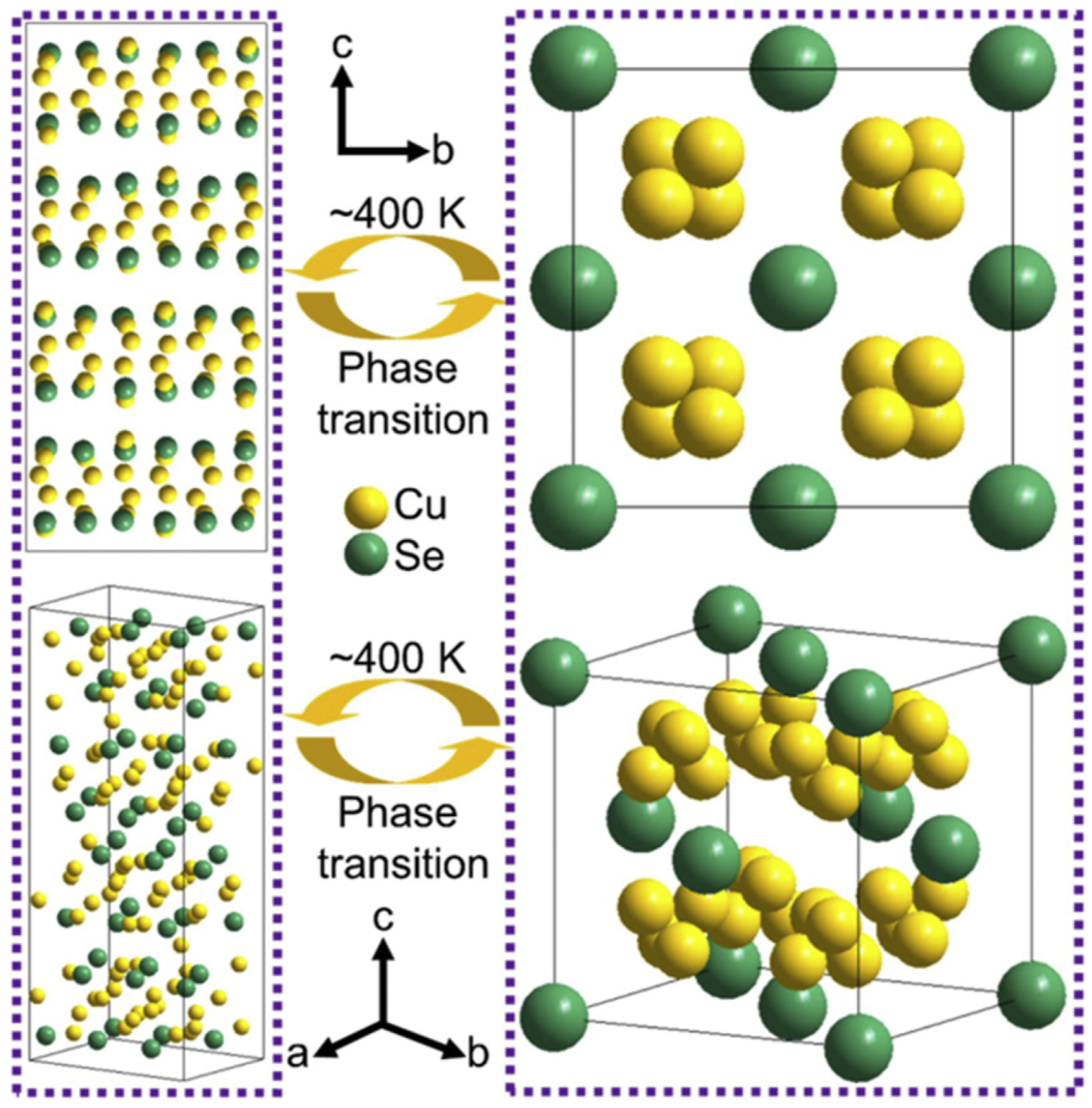
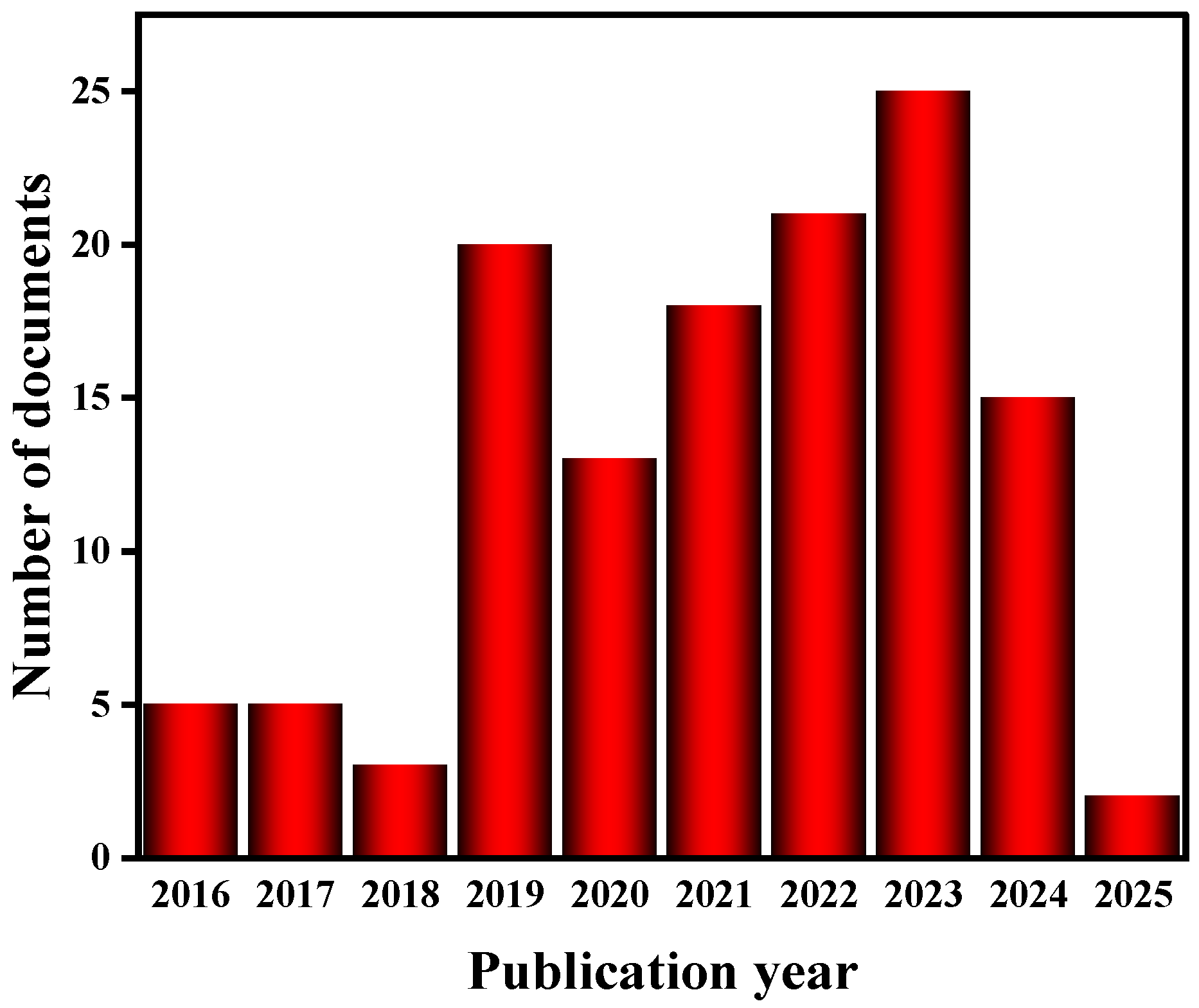

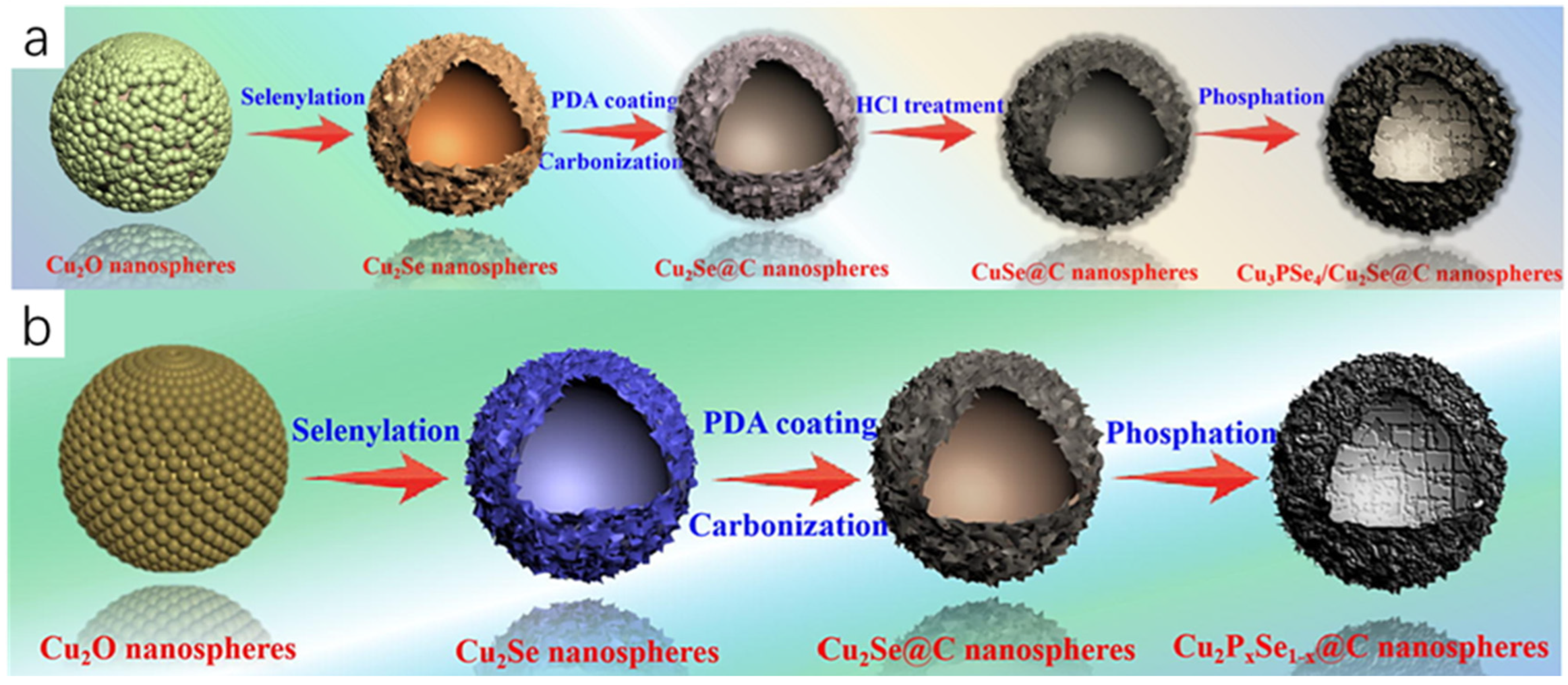

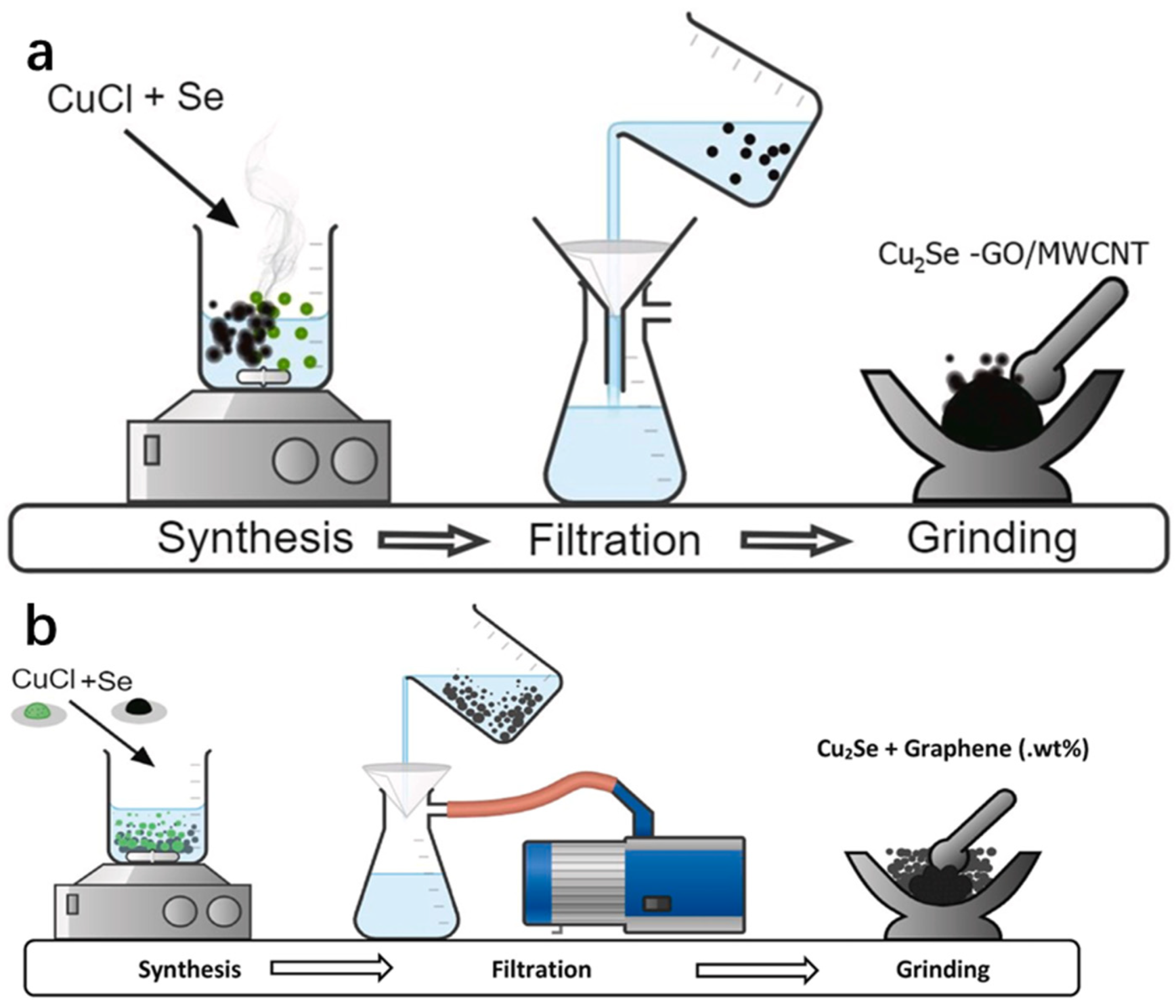
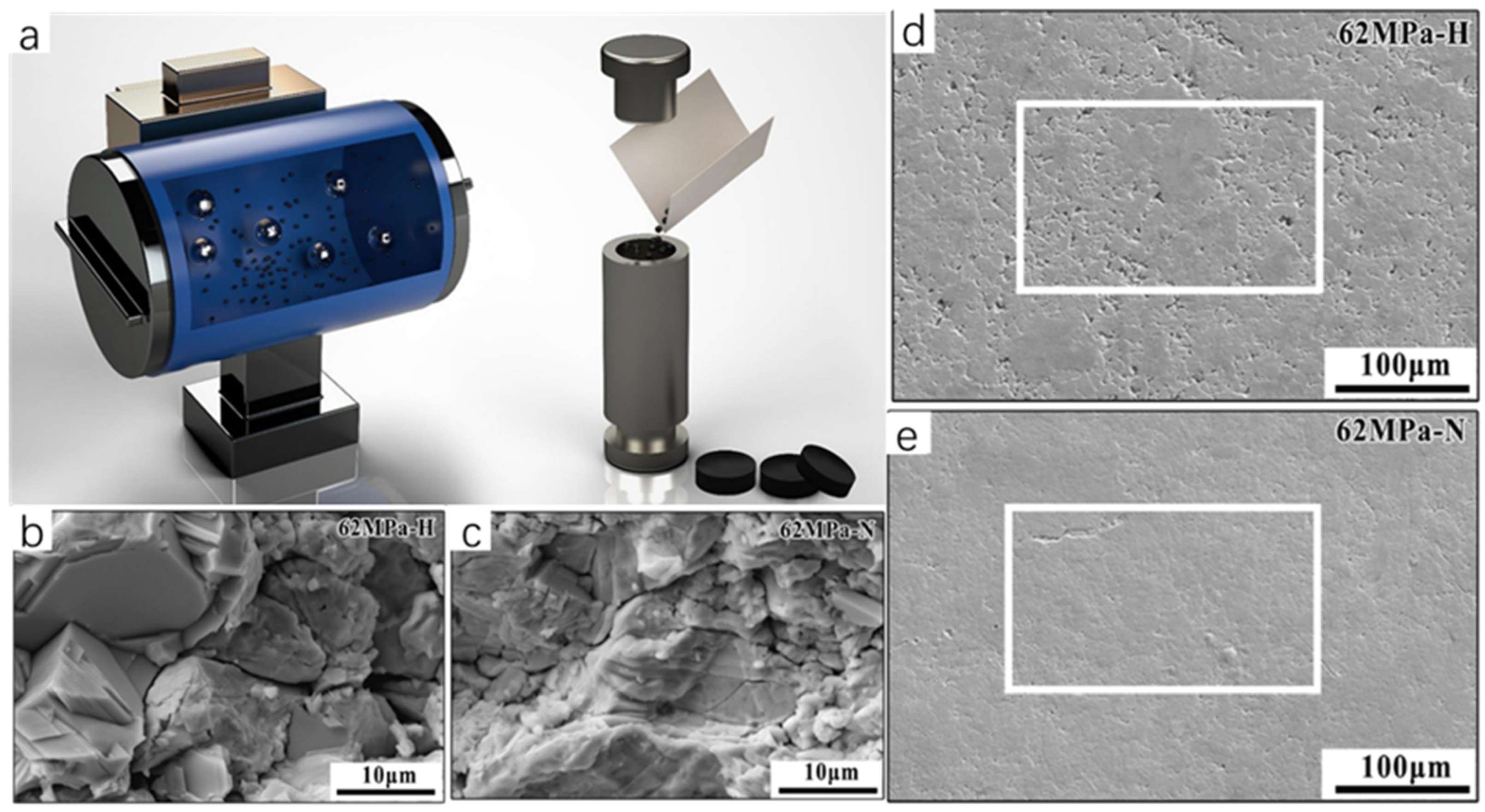
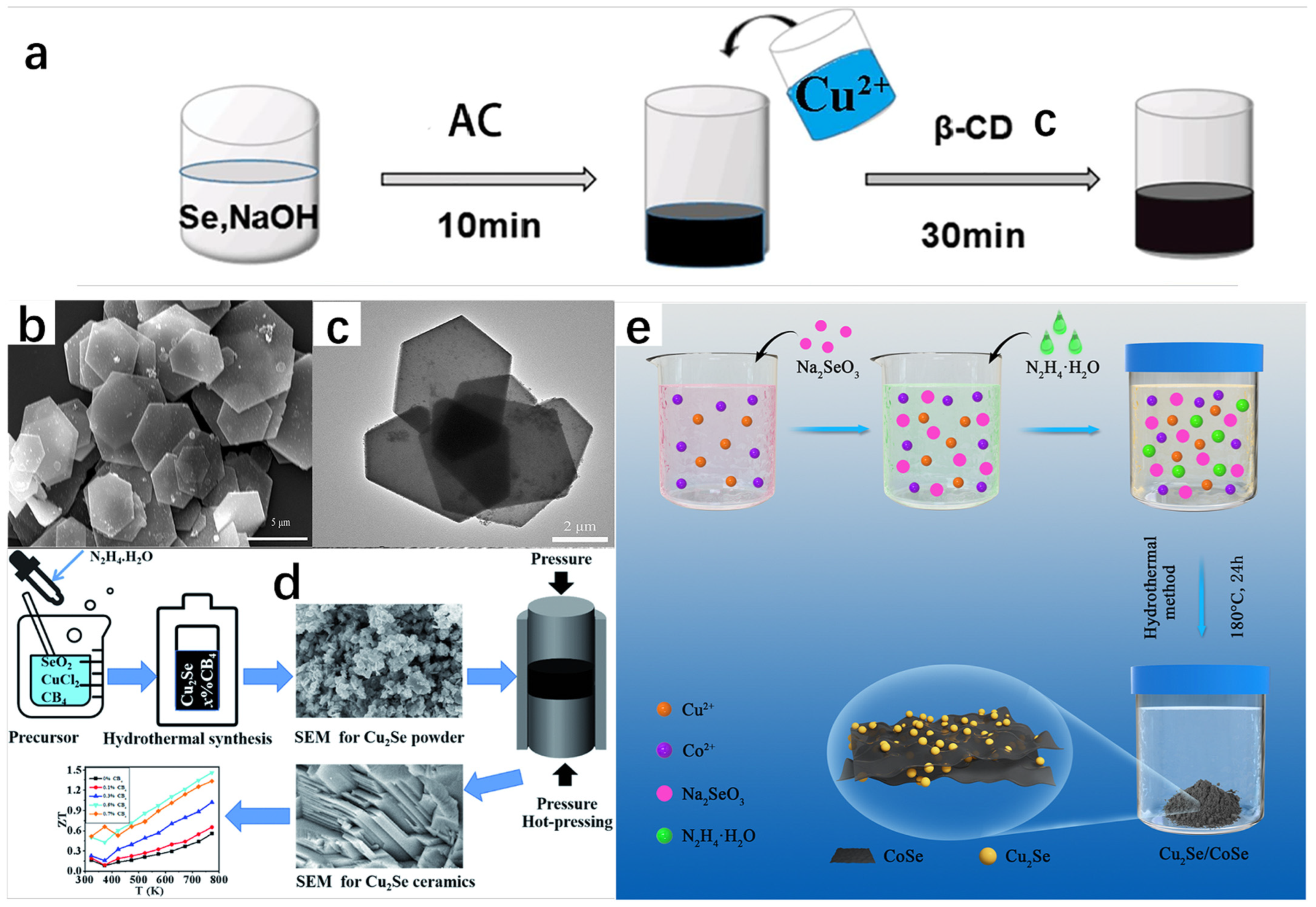
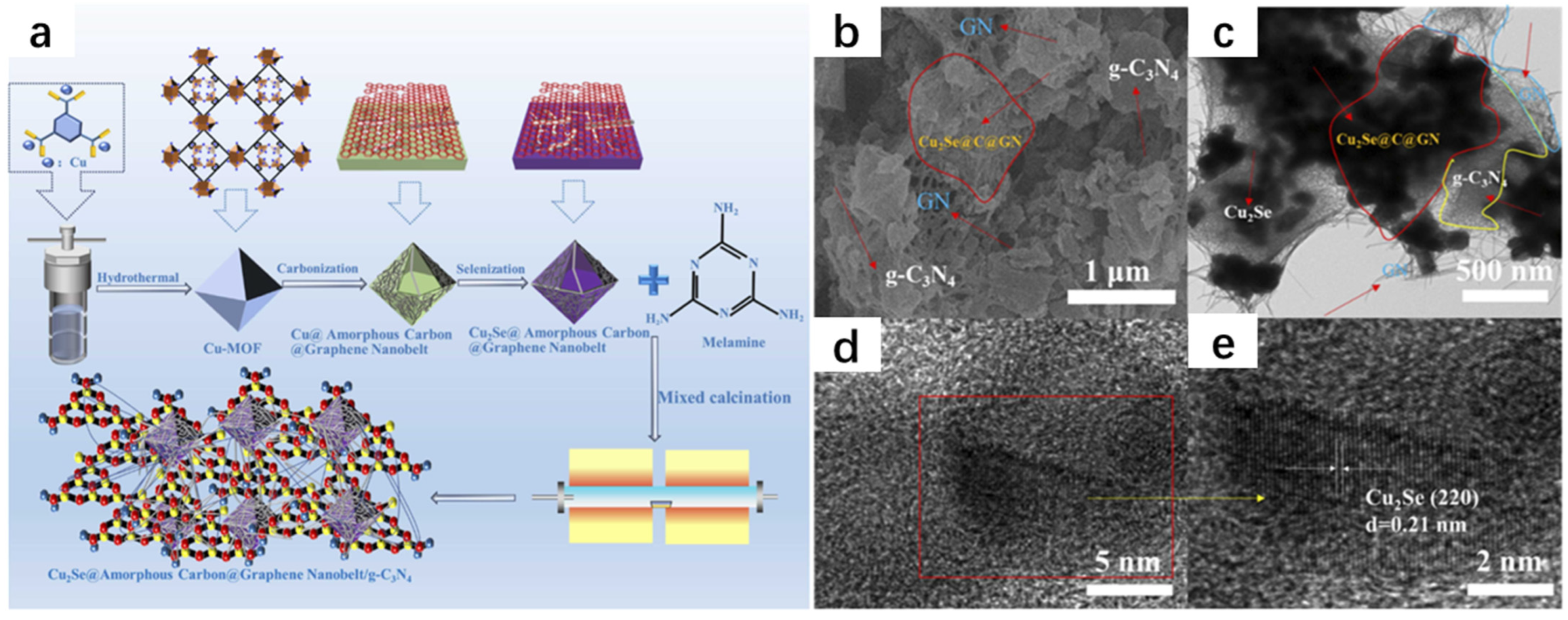

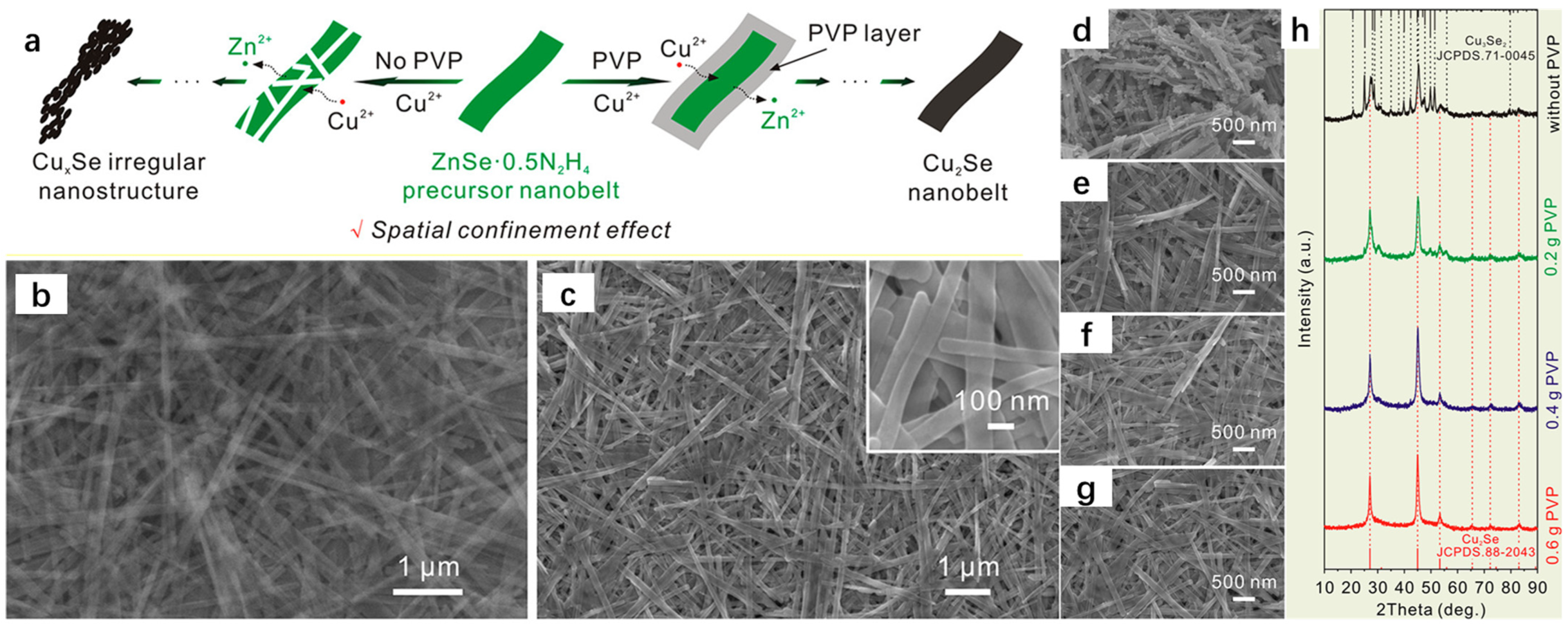
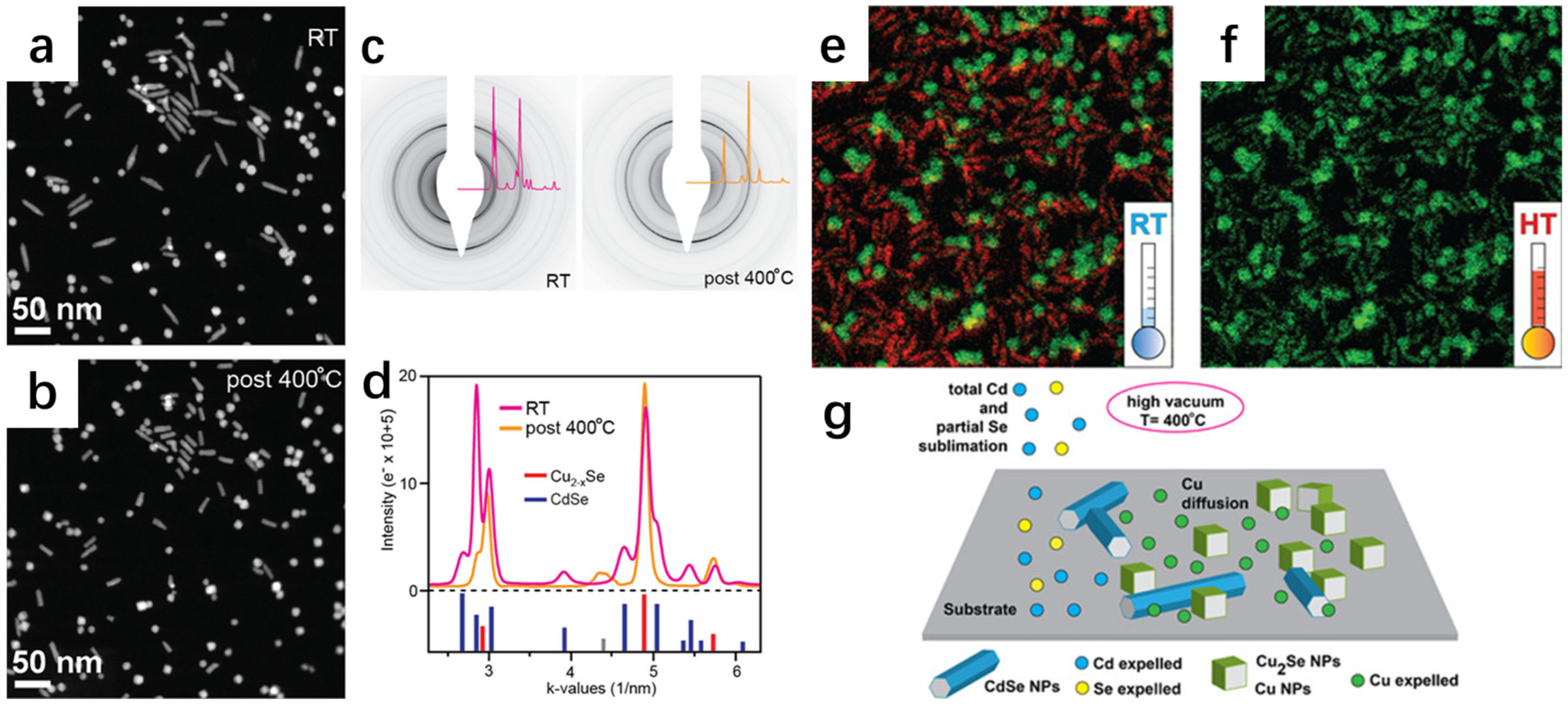
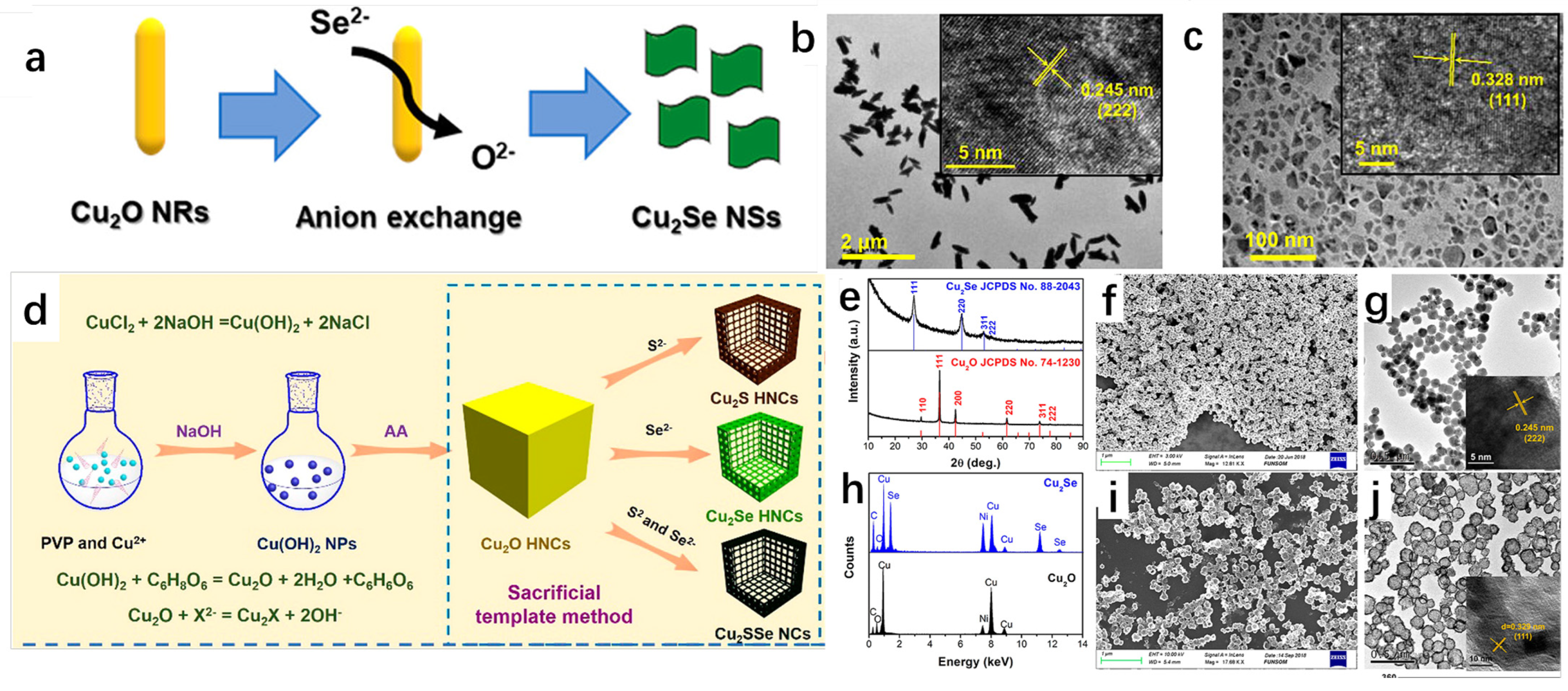

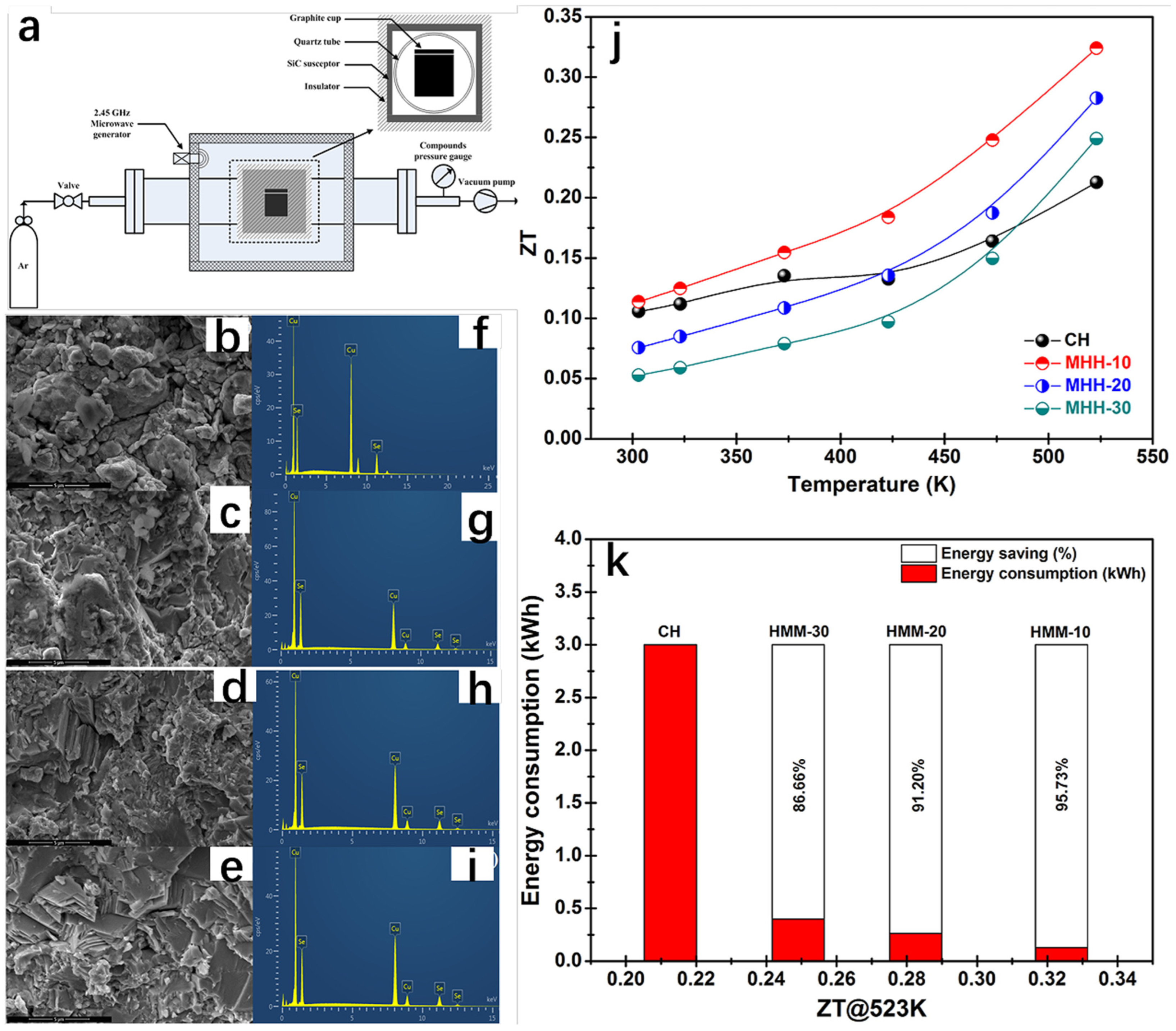
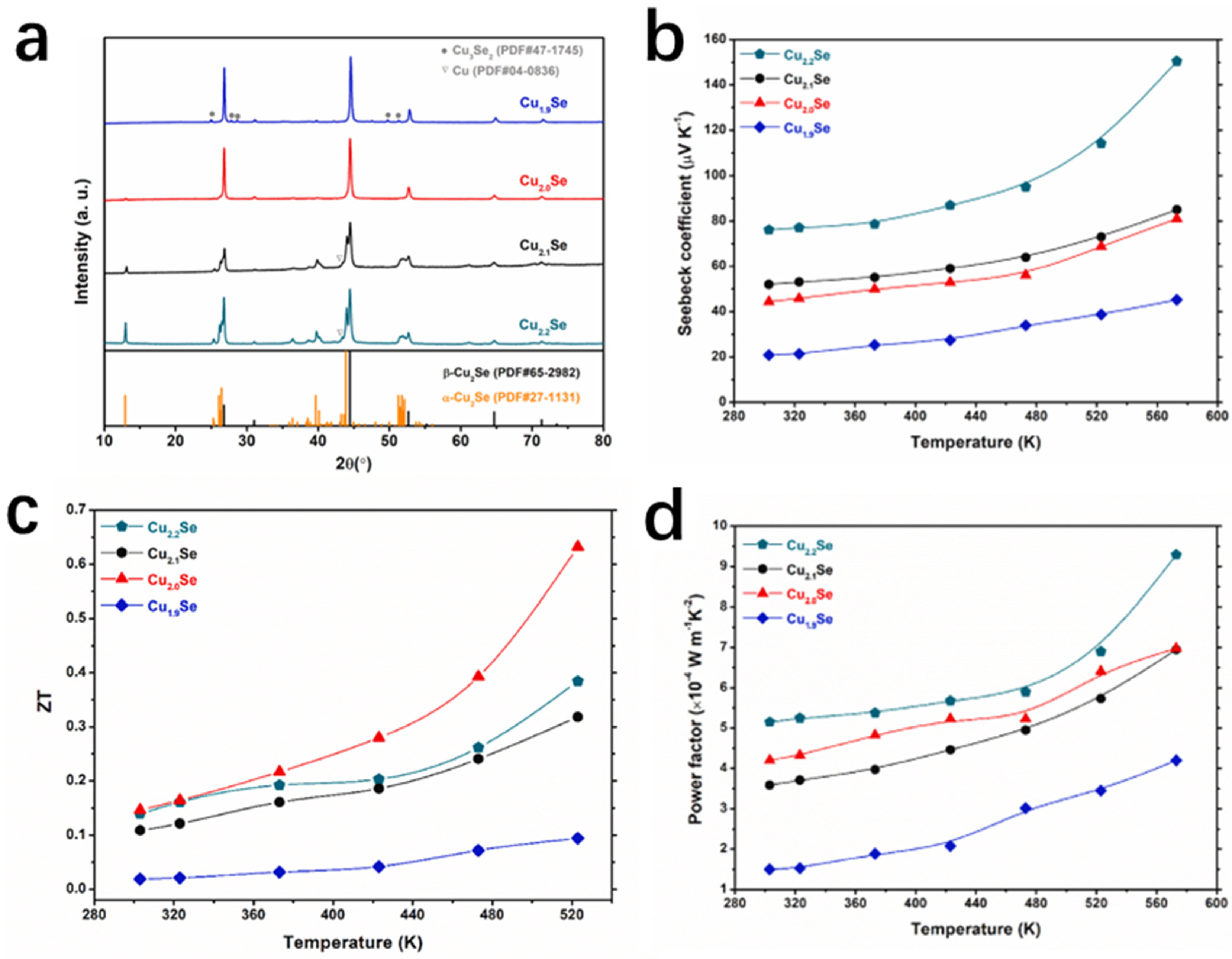
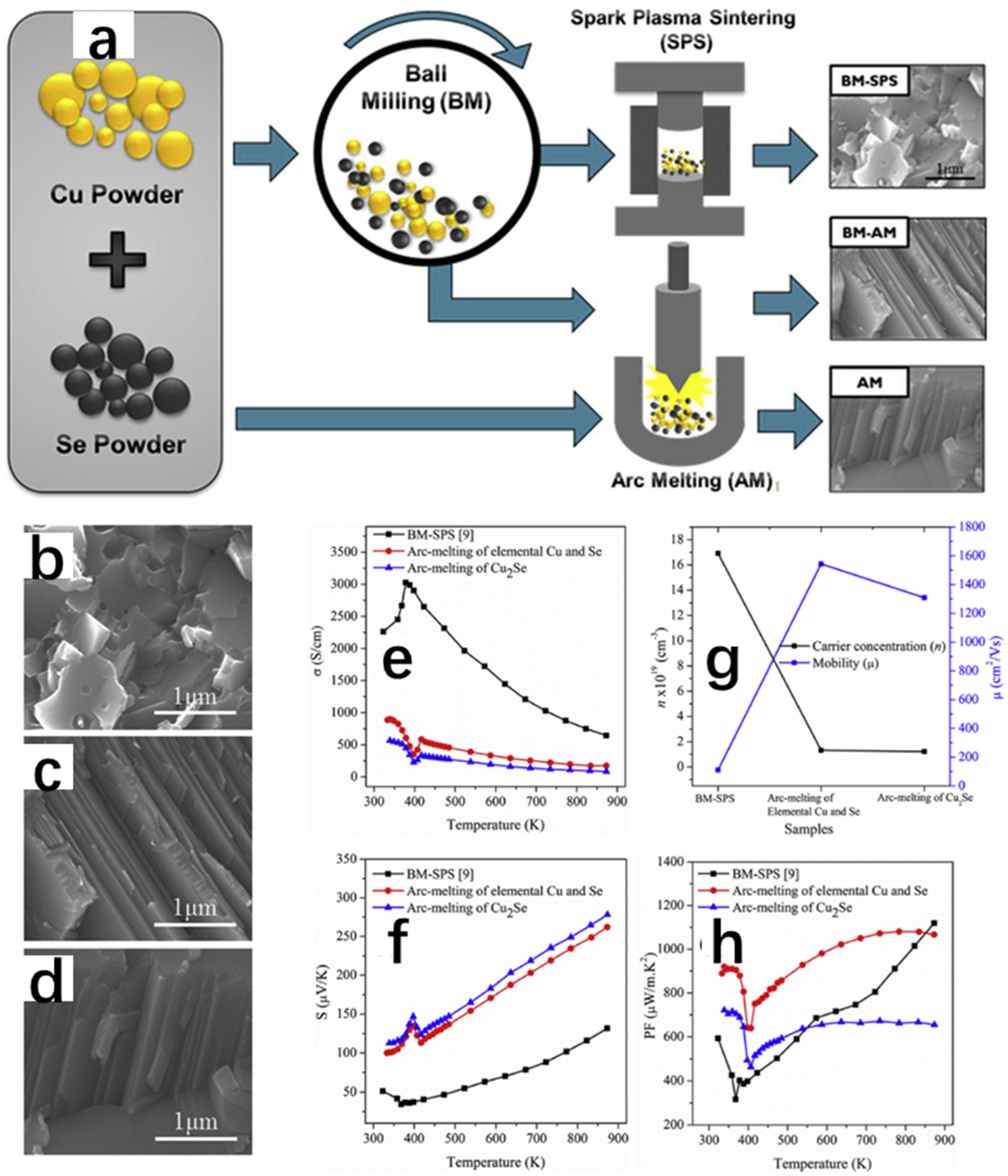
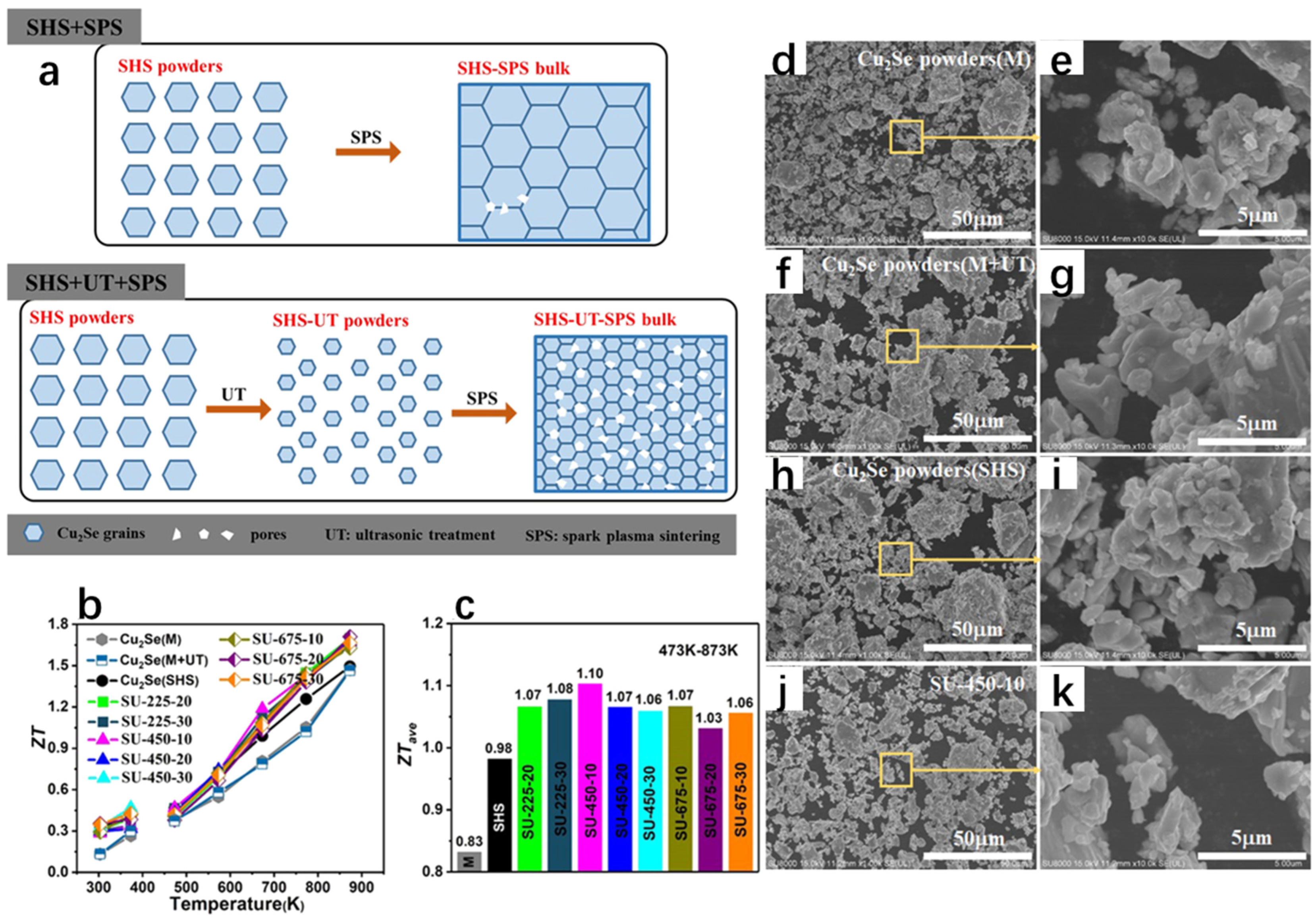
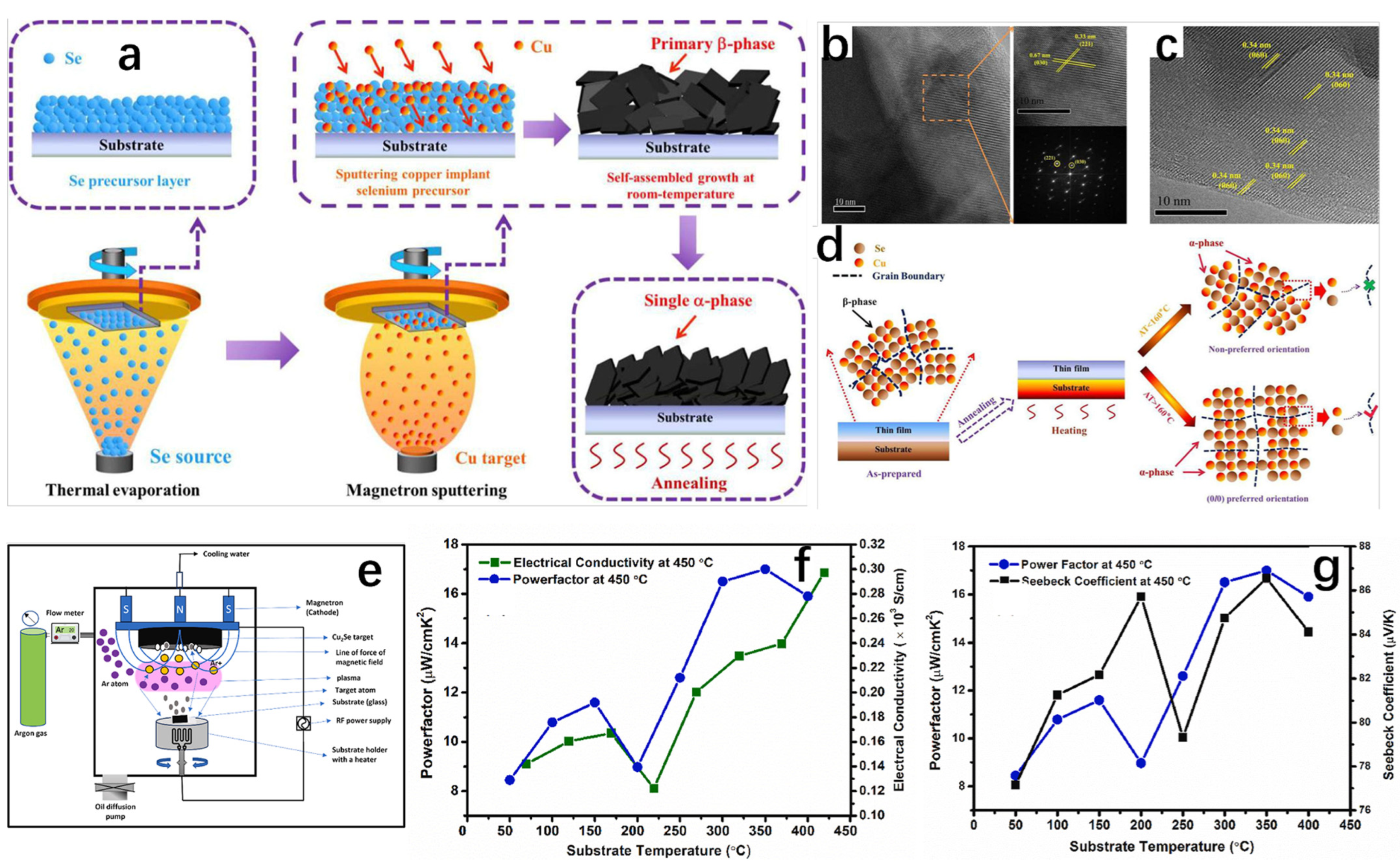
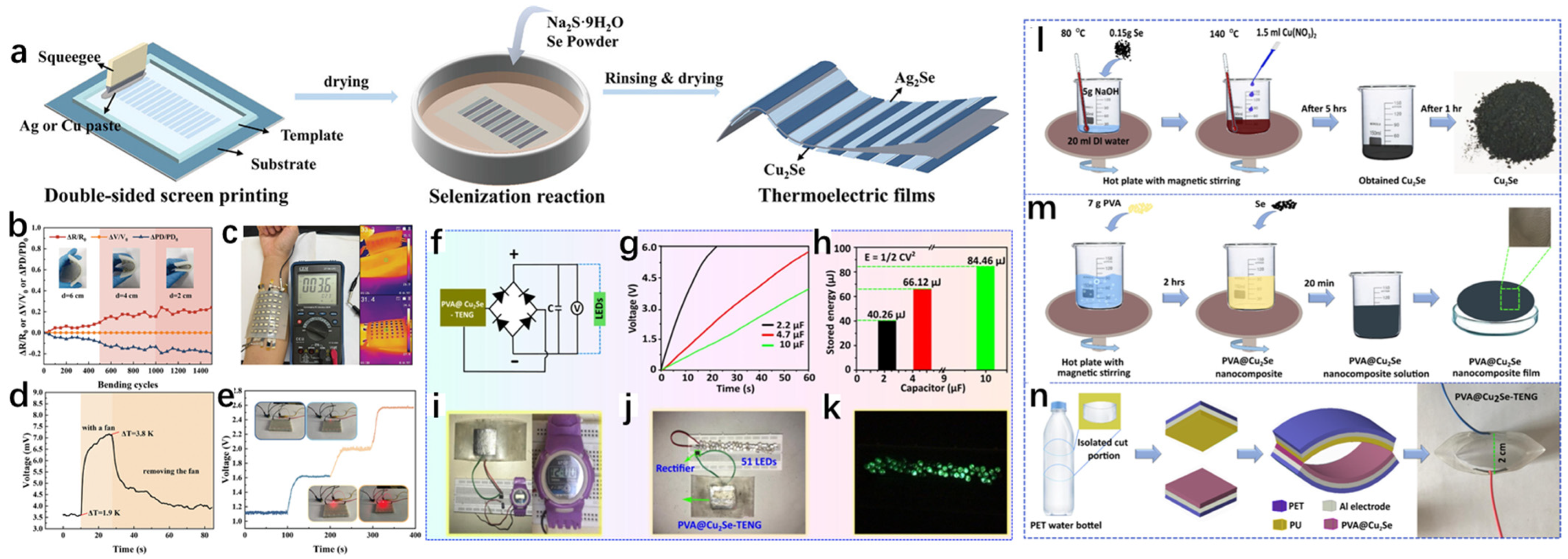
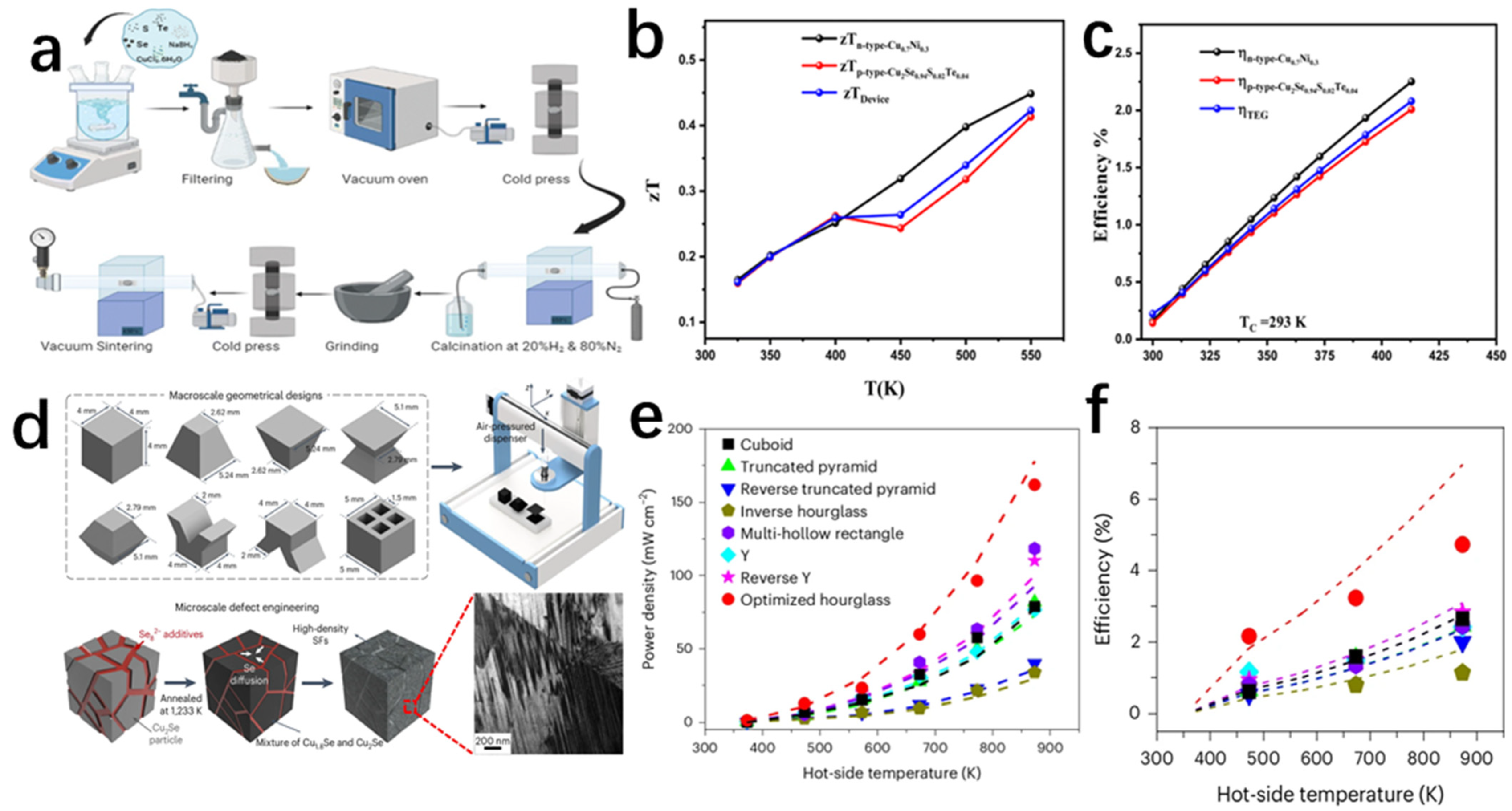


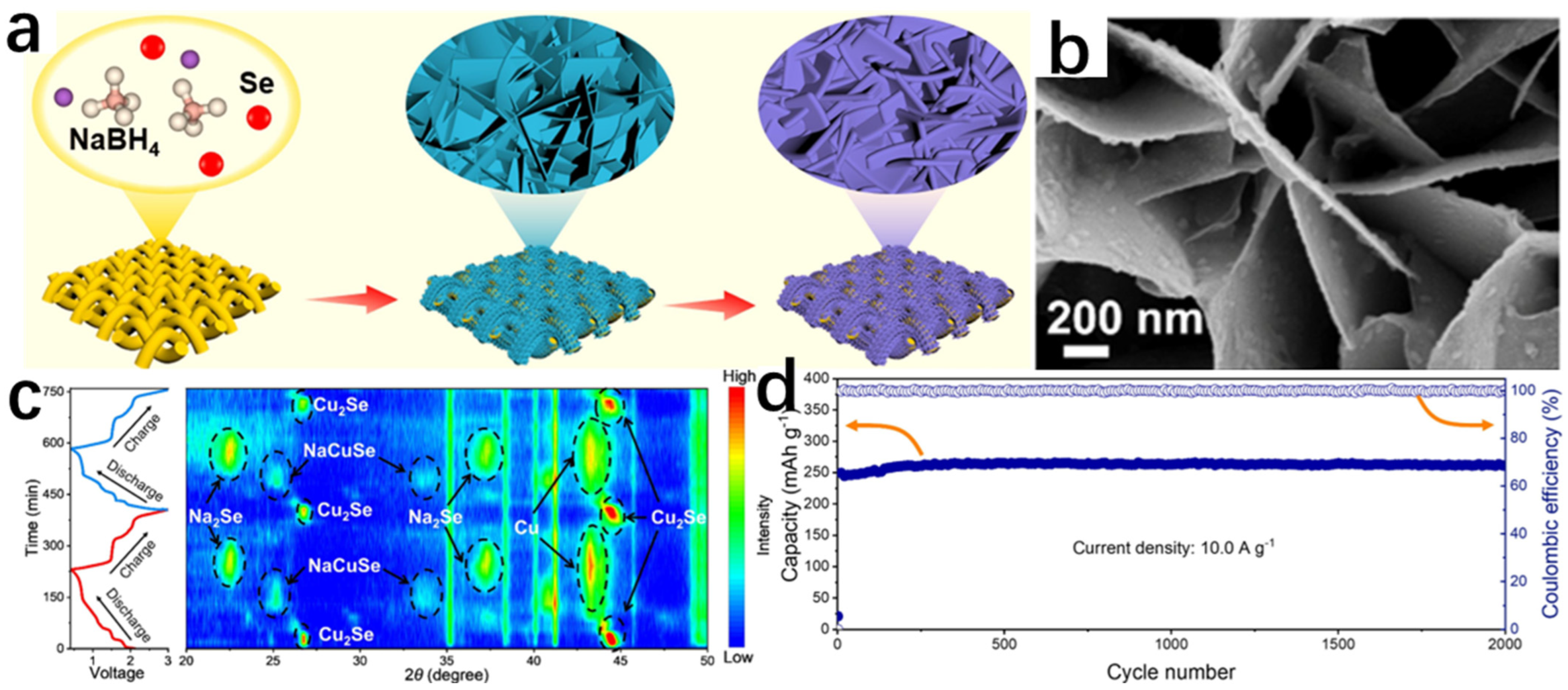

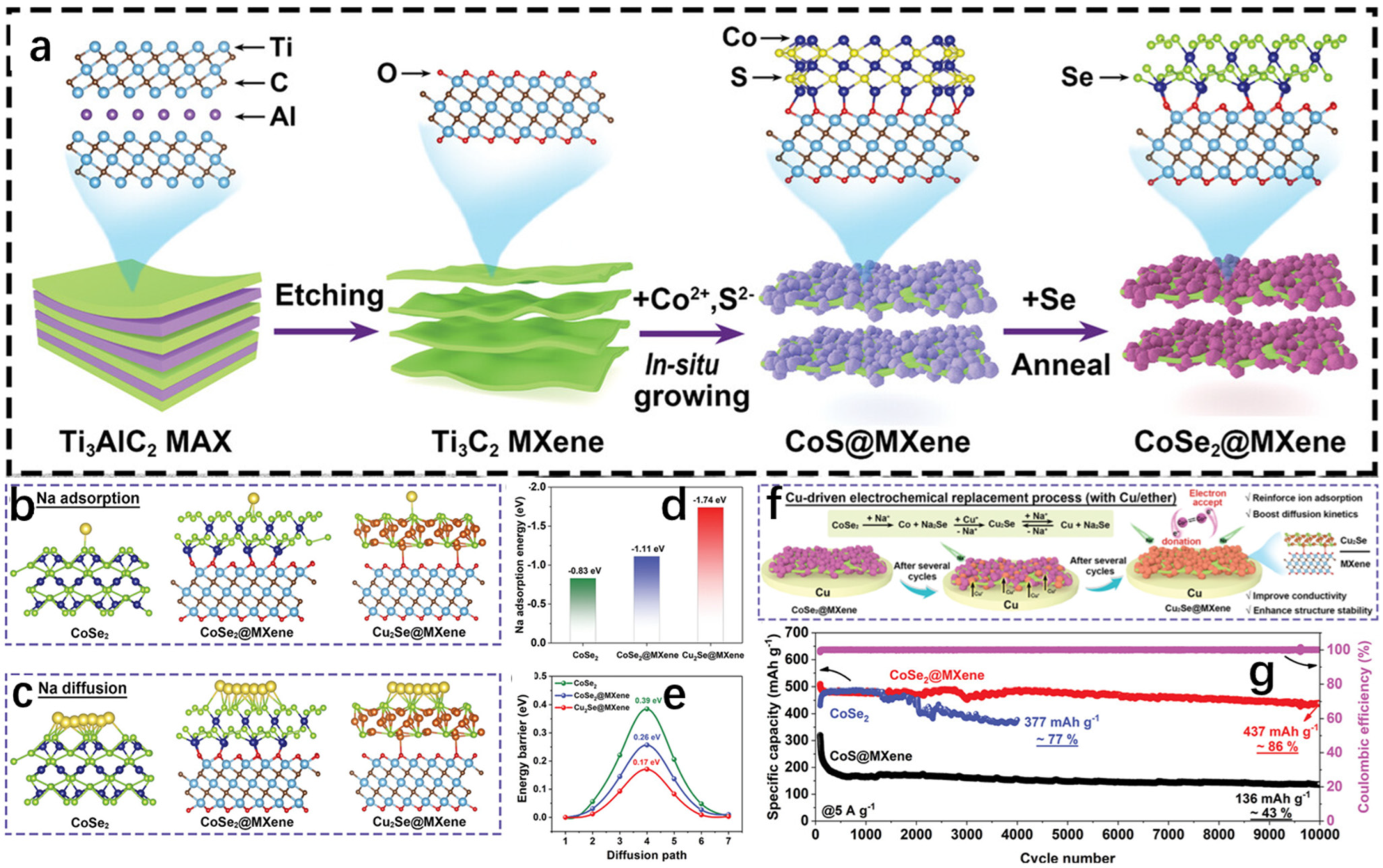

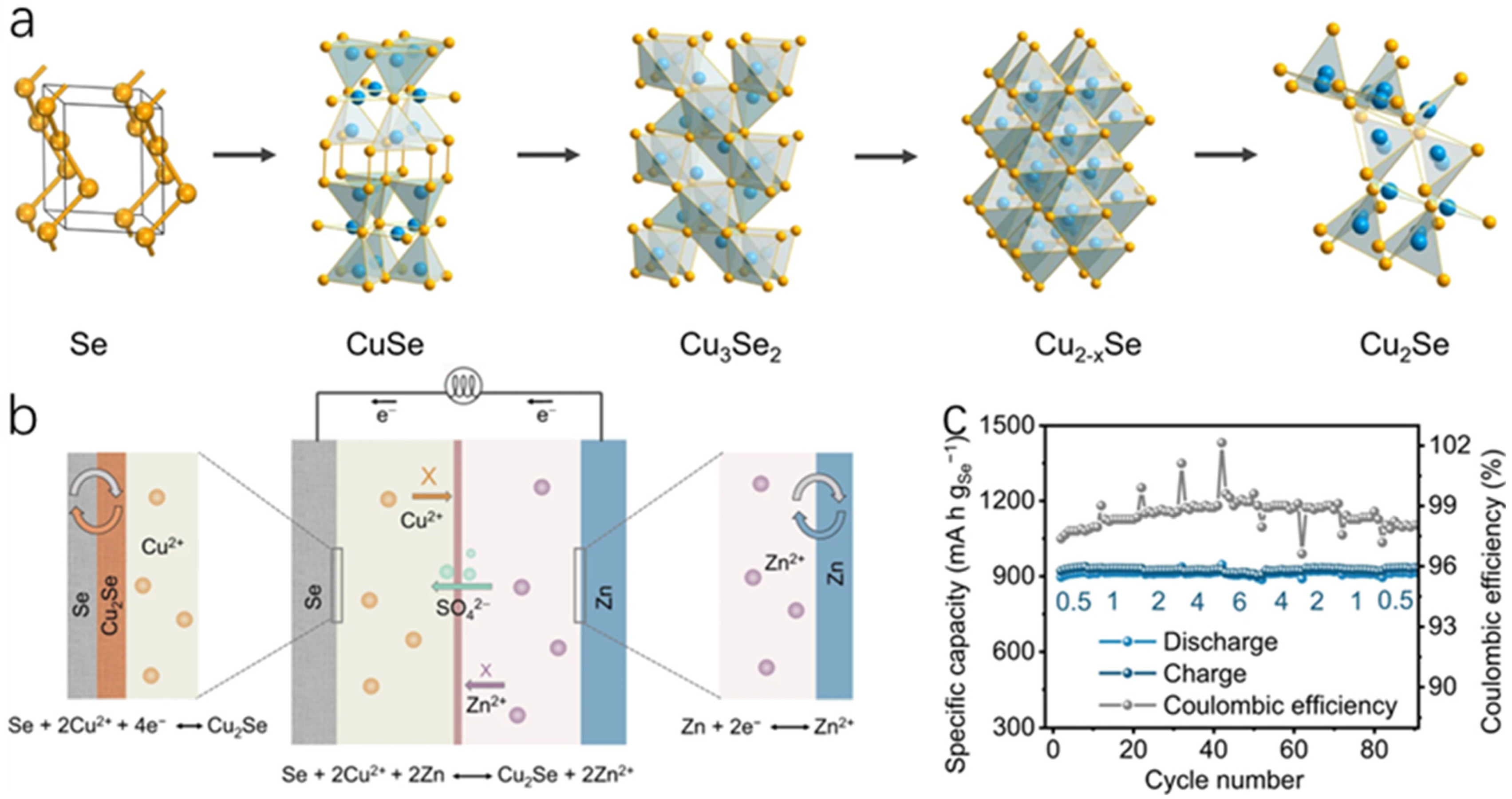
| Synthesis Methods | Advantages | Disadvantages |
|---|---|---|
| Template-guided method | Precise control of the size and shape of the product, so as to achieve precise control of the product; the synthesized new material can well retain the size and shape of the raw material. | Difficult to select templates, cumbersome, and difficult to operate. |
| Chemical reduction | Simple to operate; no need for expensive equipment and tedious steps; easy to control. | Introduces new impurities that are difficult to remove and pollutes the environment. |
| Solid-phase method | High yield of prepared powder; basically no agglomeration phenomenon; good filling; low production cost; simple and easy to master the technology. | Low reaction efficiency; high energy consumption; large powder particles; often mixed with impurities in the preparation process. |
| Hydrothermal/solvent-thermal | Sintering is not required during the reaction process, which can avoid excessive growth of grains and the mixing of impurities; the synthesized particles are well-dispersed, with high purity; the microscopic morphology of the particles is good and controllable, which does not require high cost. | The growth process of the sample cannot be visualized in a closed environment; requires certain equipment (corrosion-, high temperature-, and pressure-resistant); requires certain technology; requires strict control of temperature and pressure. |
| Ion exchange method | The morphology of precursor can be well preserved; the process is simple, easy to operate, causing less pollution. | Difficult to remove impurities during the synthesis process; long synthesis period, etc. |
Disclaimer/Publisher’s Note: The statements, opinions and data contained in all publications are solely those of the individual author(s) and contributor(s) and not of MDPI and/or the editor(s). MDPI and/or the editor(s) disclaim responsibility for any injury to people or property resulting from any ideas, methods, instructions or products referred to in the content. |
© 2025 by the authors. Licensee MDPI, Basel, Switzerland. This article is an open access article distributed under the terms and conditions of the Creative Commons Attribution (CC BY) license (https://creativecommons.org/licenses/by/4.0/).
Share and Cite
Zhang, K.; Li, S.; Zhu, M. Synthesis of Cu2Se-Based Materials and Their Application in Energy Conversion and Storage. Molecules 2025, 30, 4074. https://doi.org/10.3390/molecules30204074
Zhang K, Li S, Zhu M. Synthesis of Cu2Se-Based Materials and Their Application in Energy Conversion and Storage. Molecules. 2025; 30(20):4074. https://doi.org/10.3390/molecules30204074
Chicago/Turabian StyleZhang, Kai, Songjun Li, and Maiyong Zhu. 2025. "Synthesis of Cu2Se-Based Materials and Their Application in Energy Conversion and Storage" Molecules 30, no. 20: 4074. https://doi.org/10.3390/molecules30204074
APA StyleZhang, K., Li, S., & Zhu, M. (2025). Synthesis of Cu2Se-Based Materials and Their Application in Energy Conversion and Storage. Molecules, 30(20), 4074. https://doi.org/10.3390/molecules30204074








